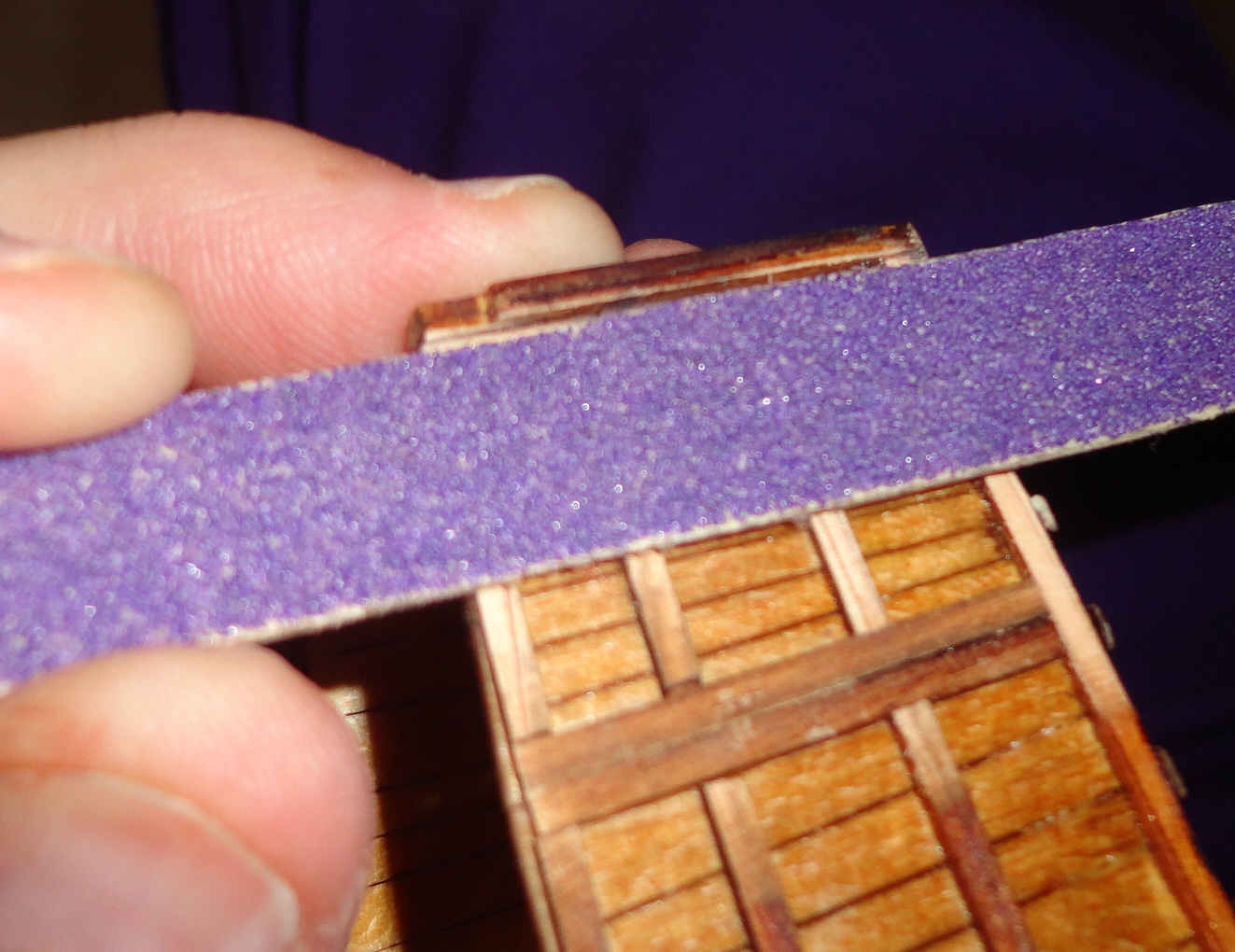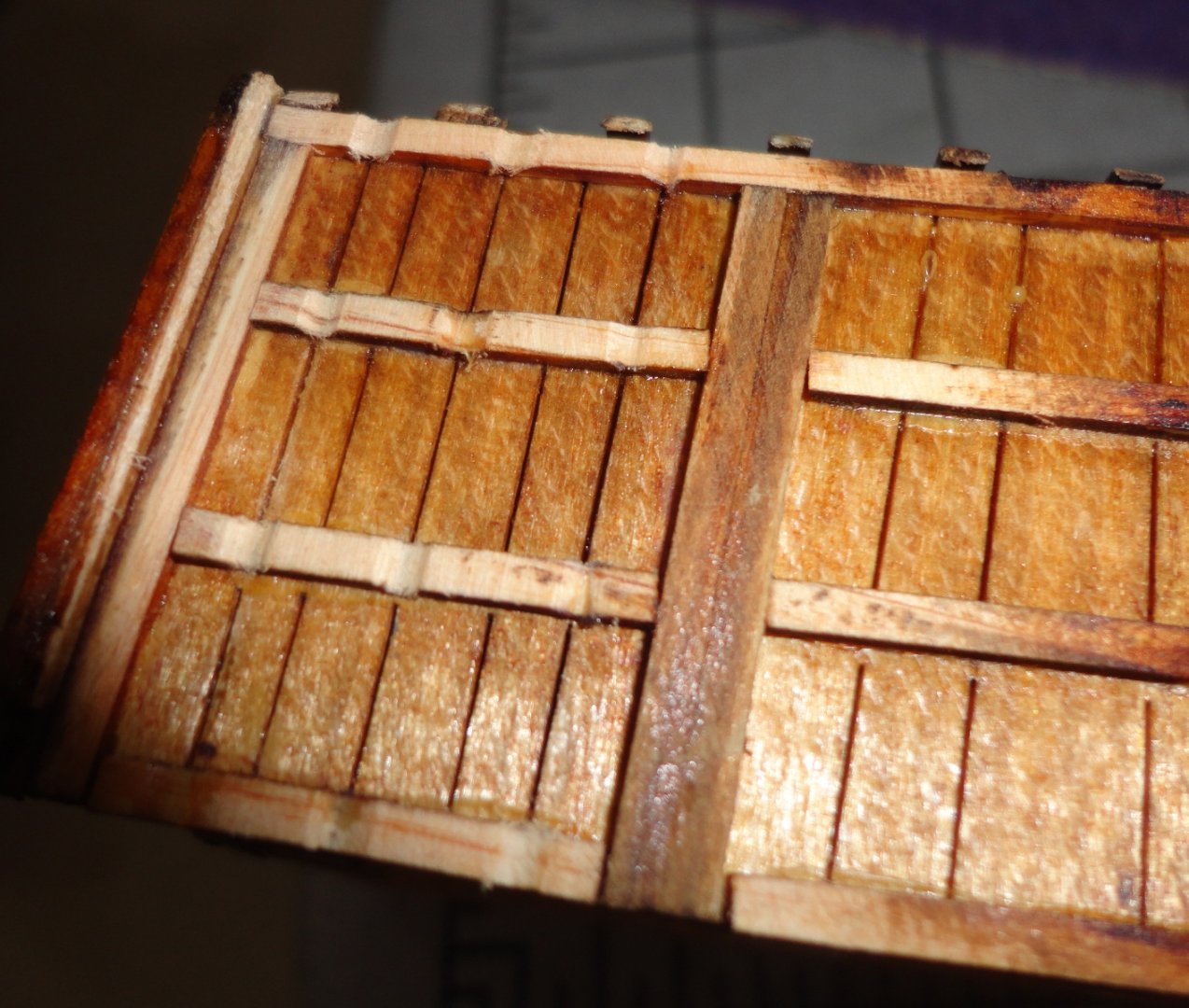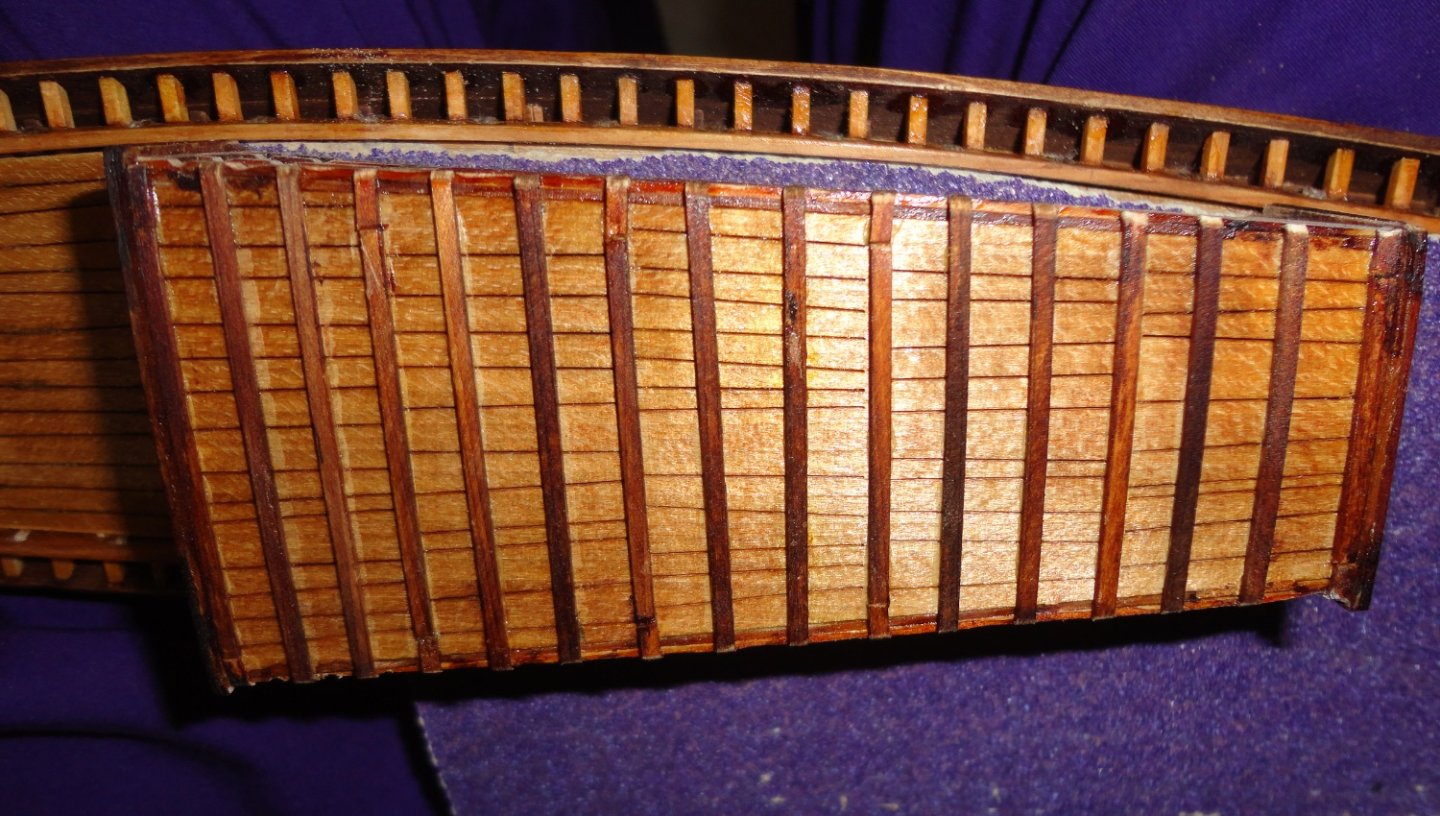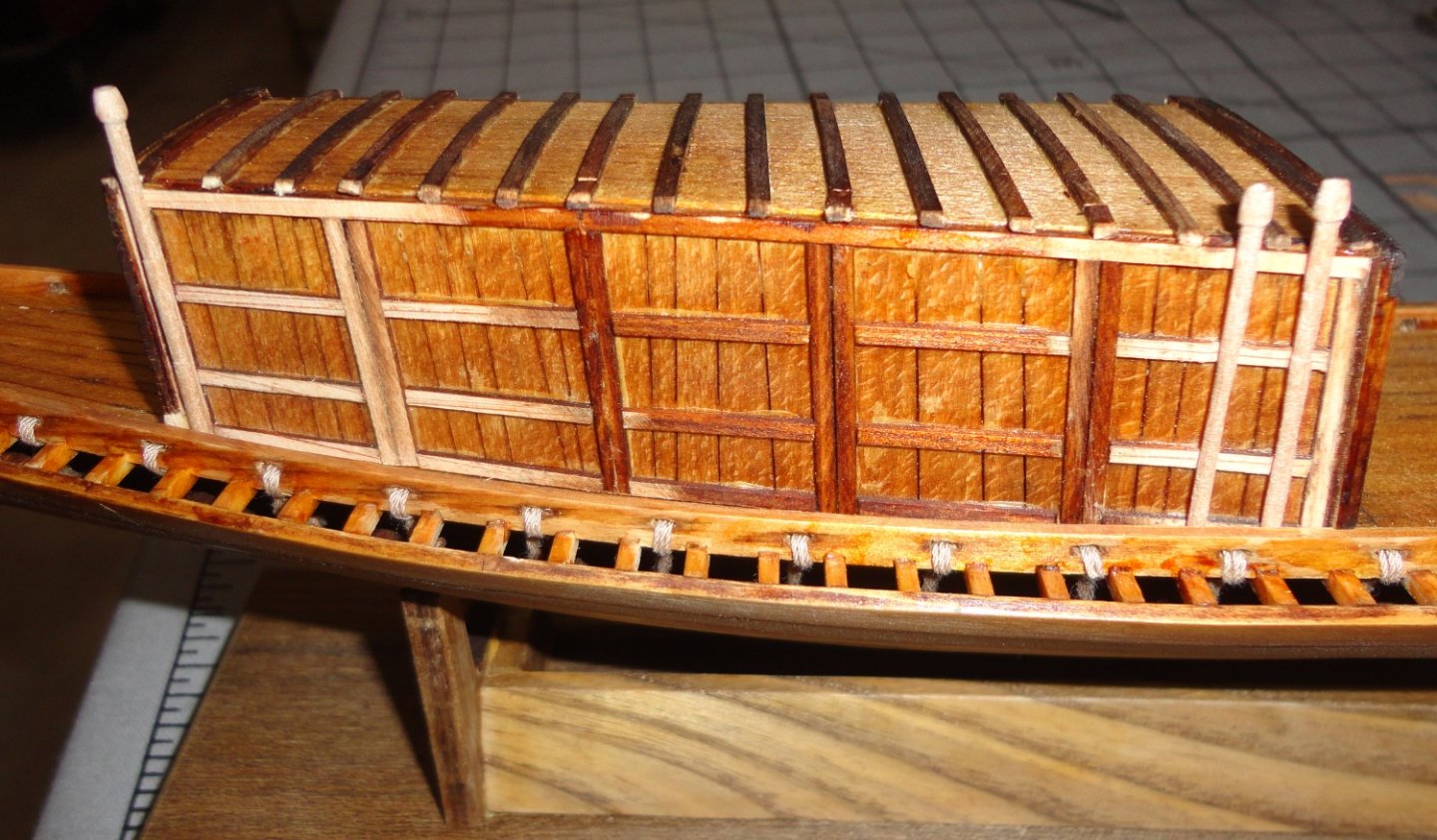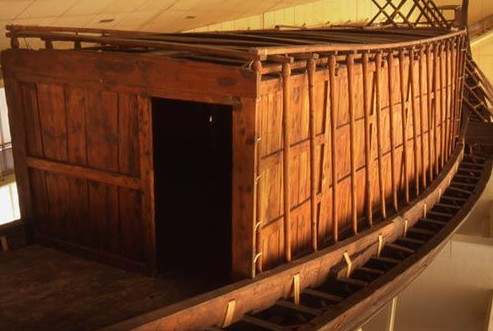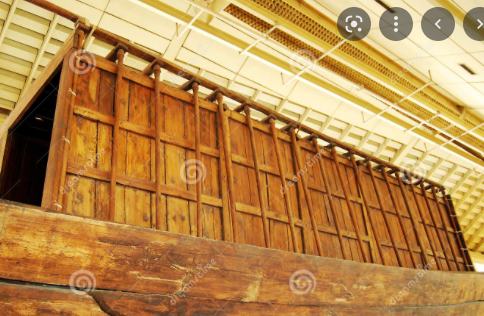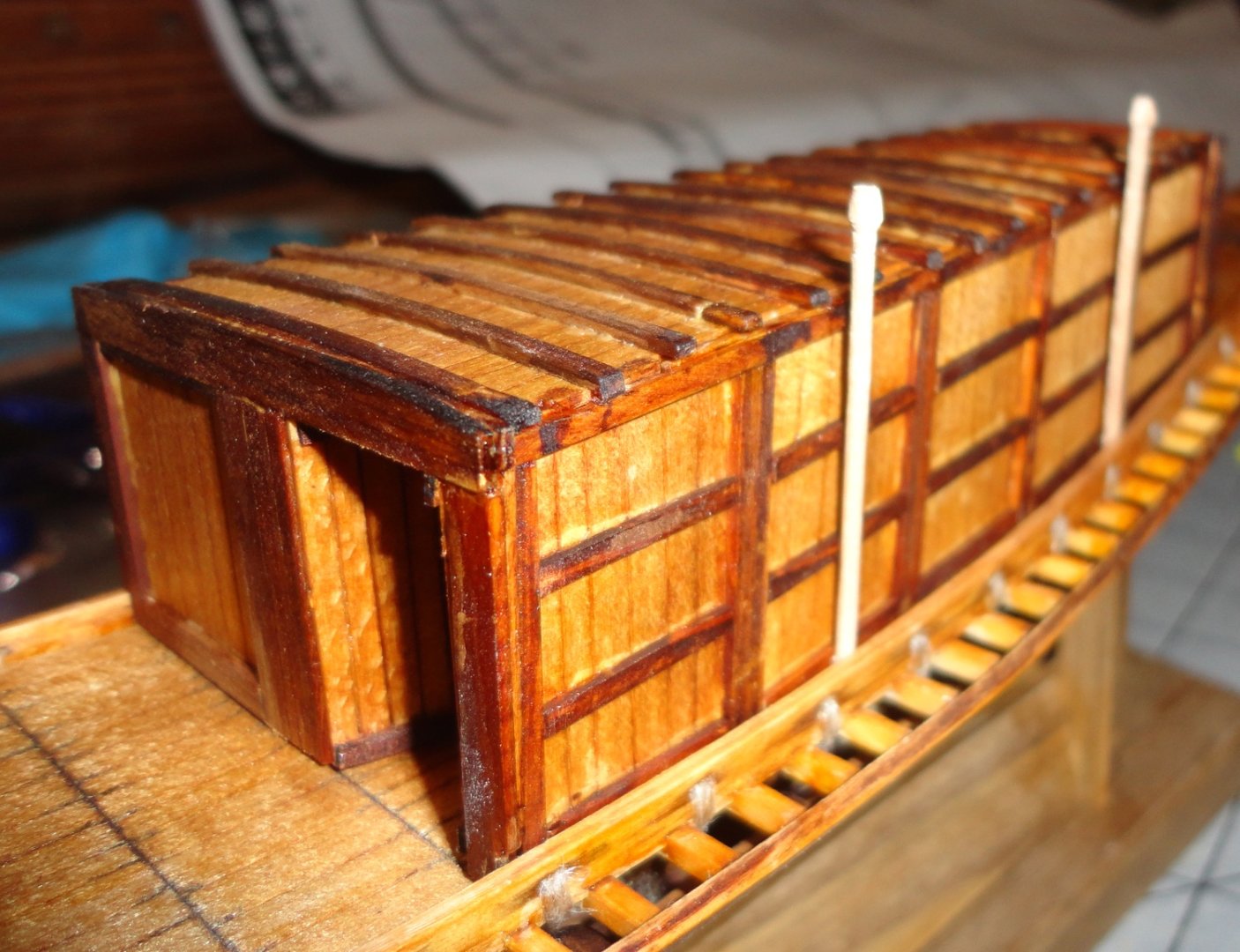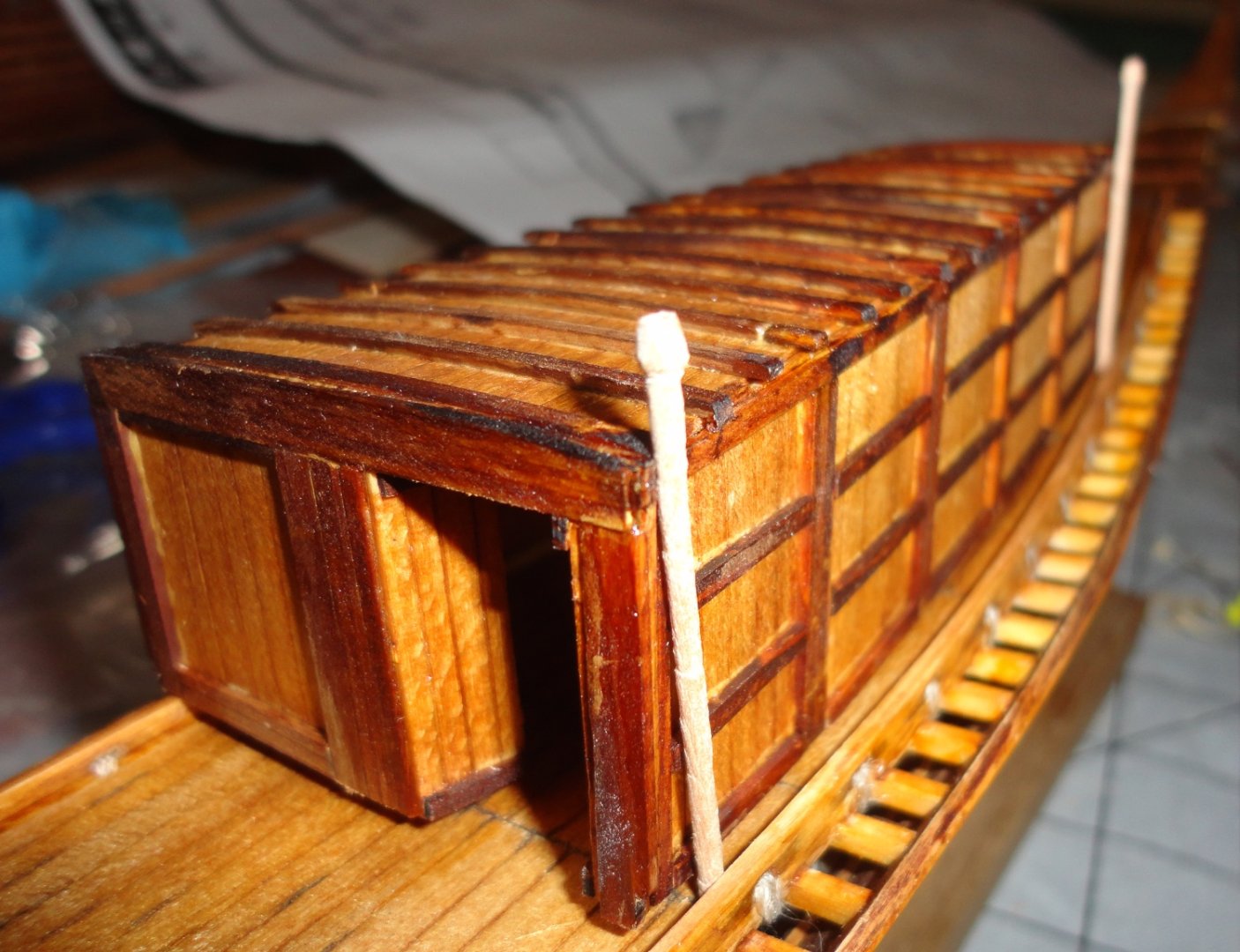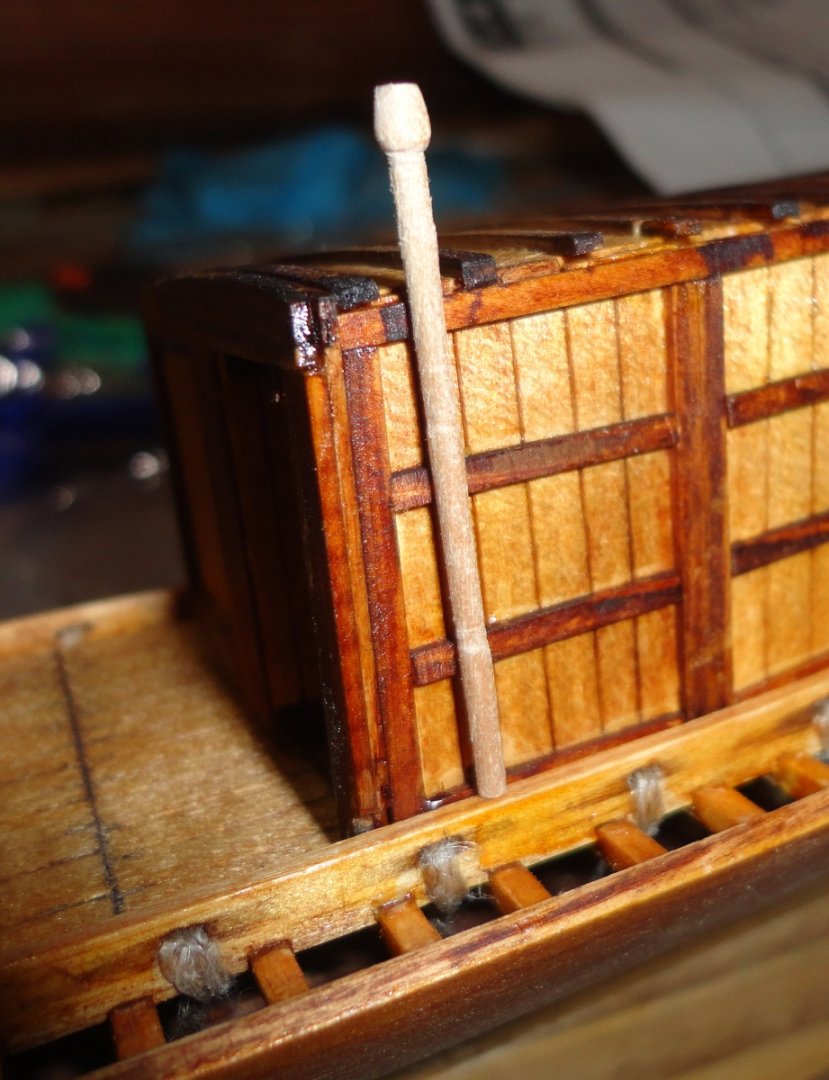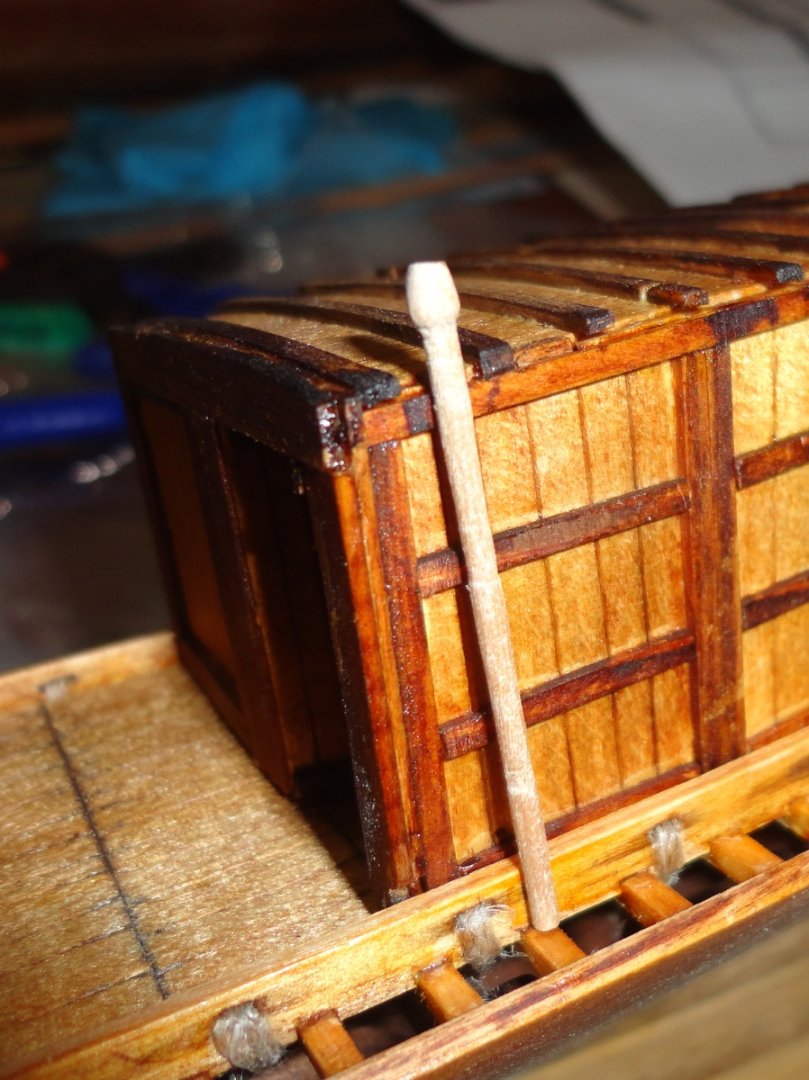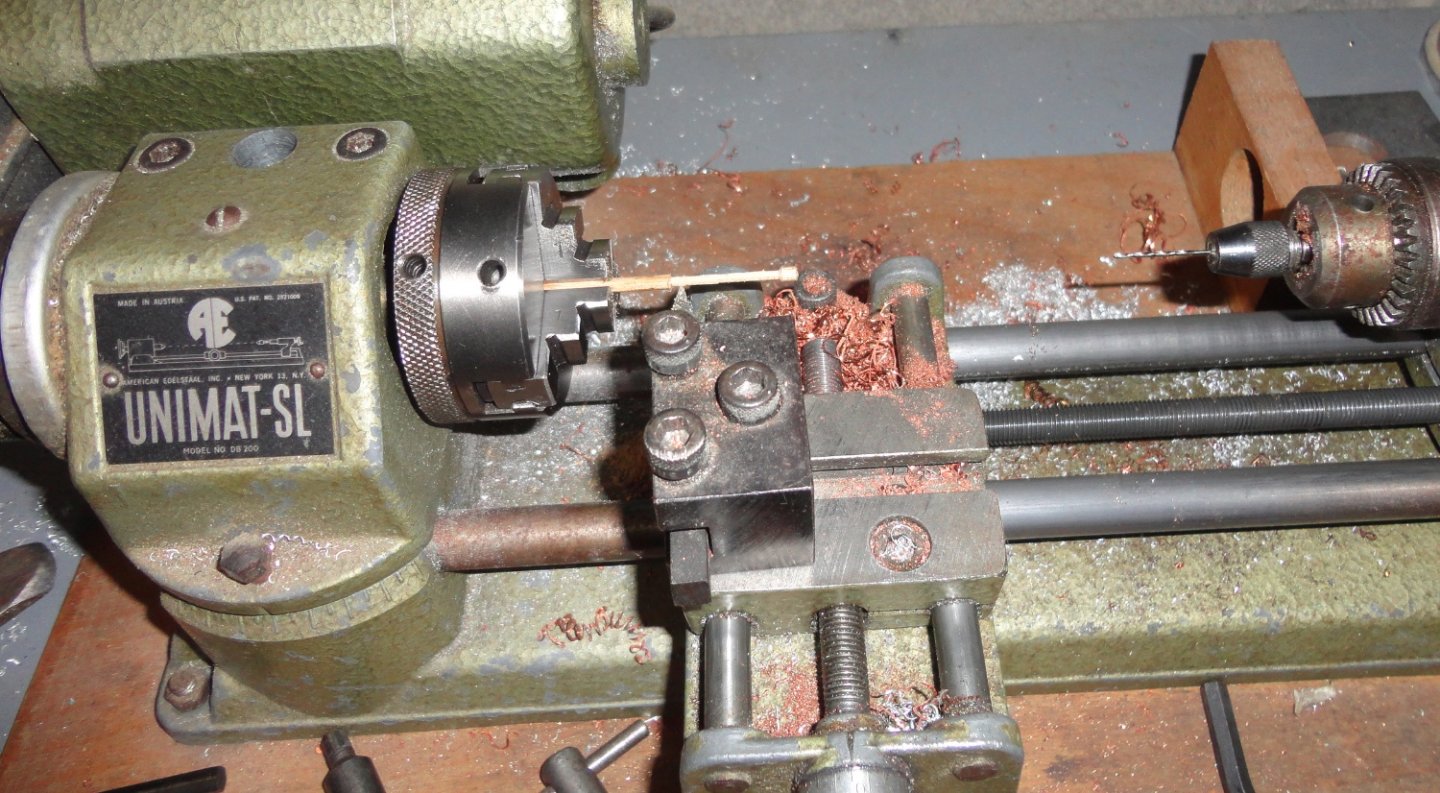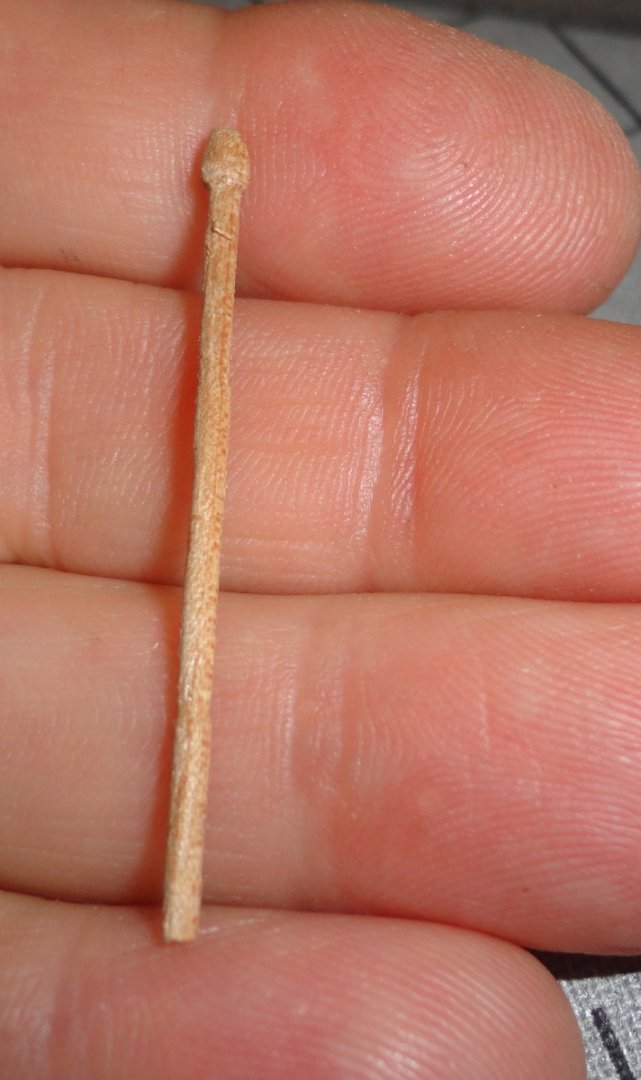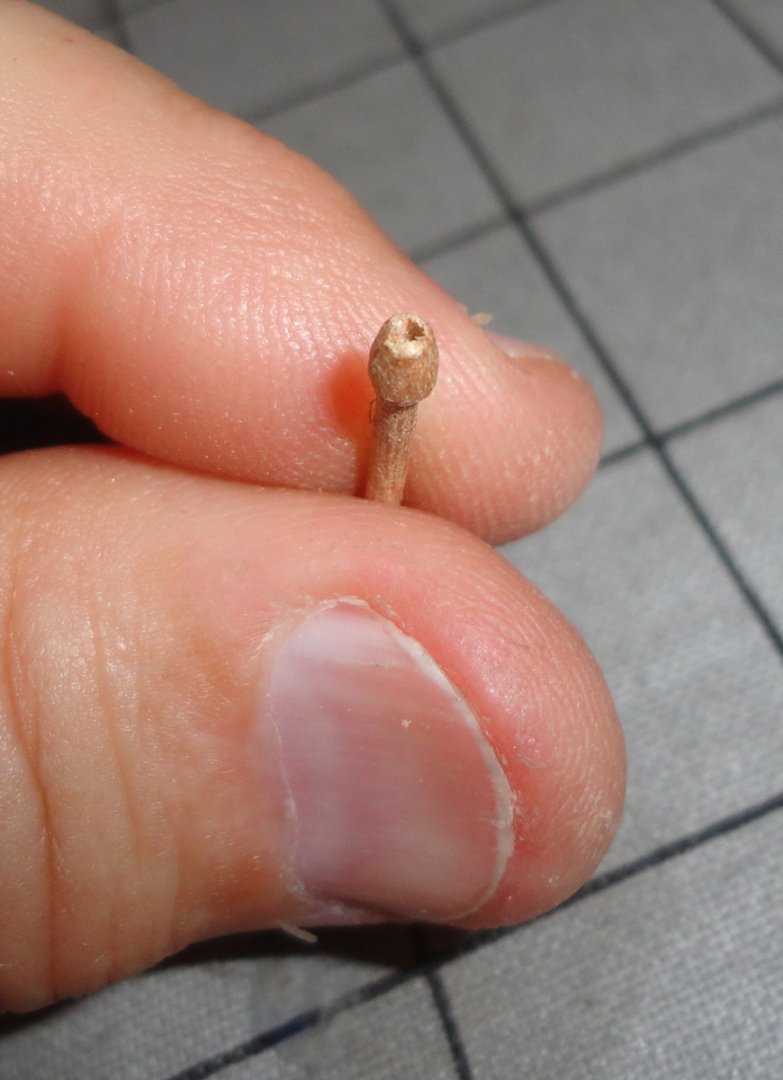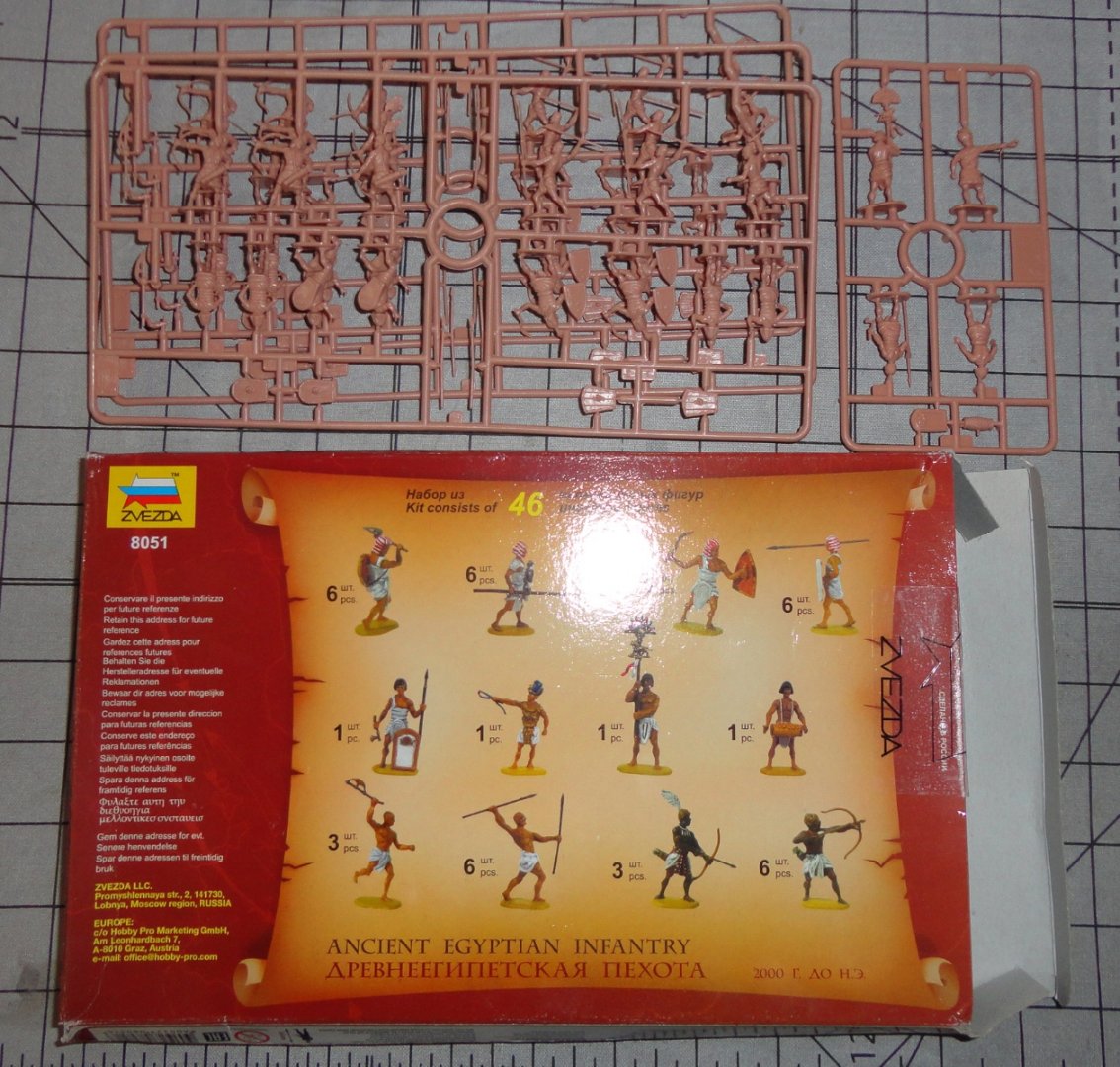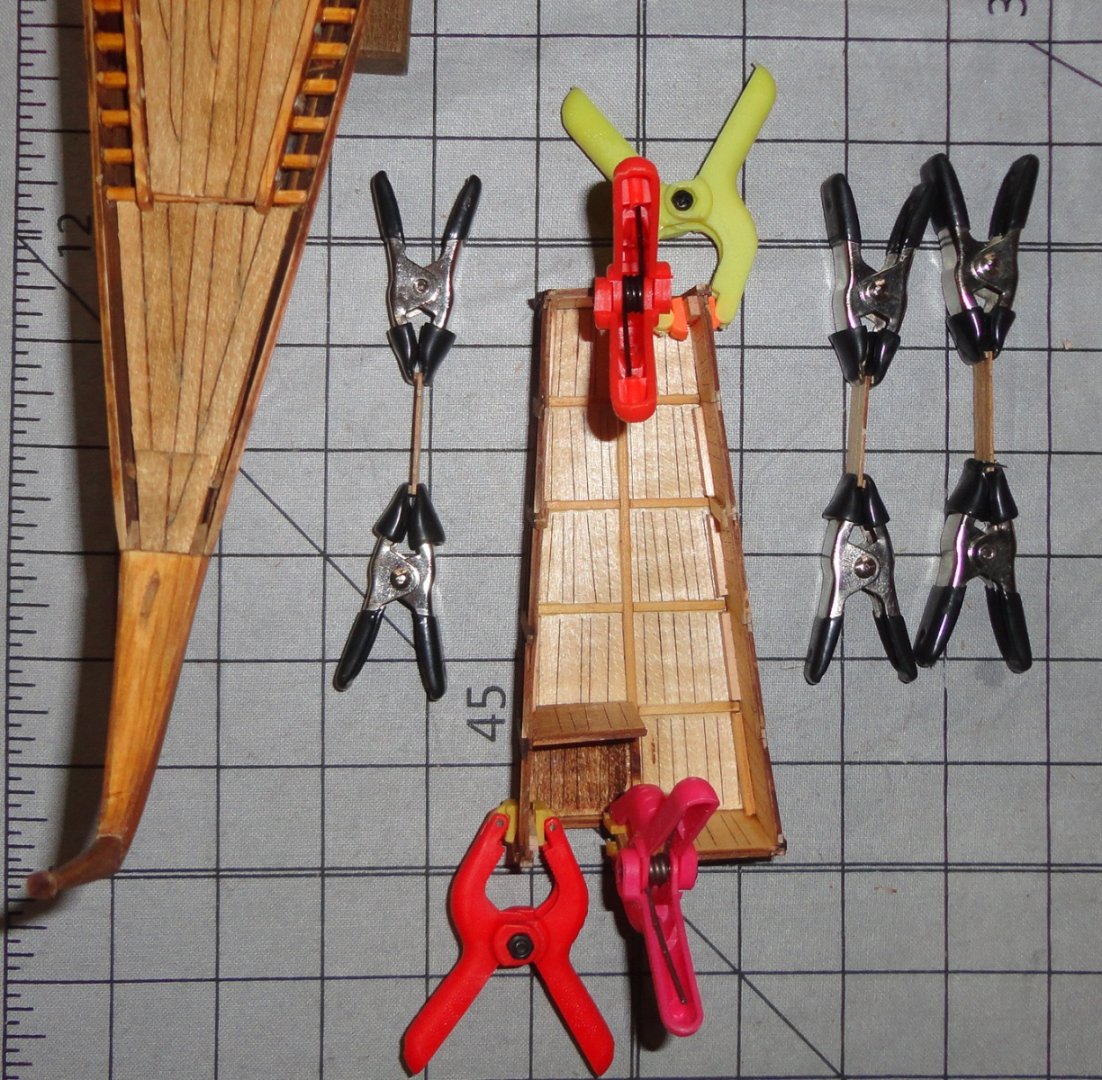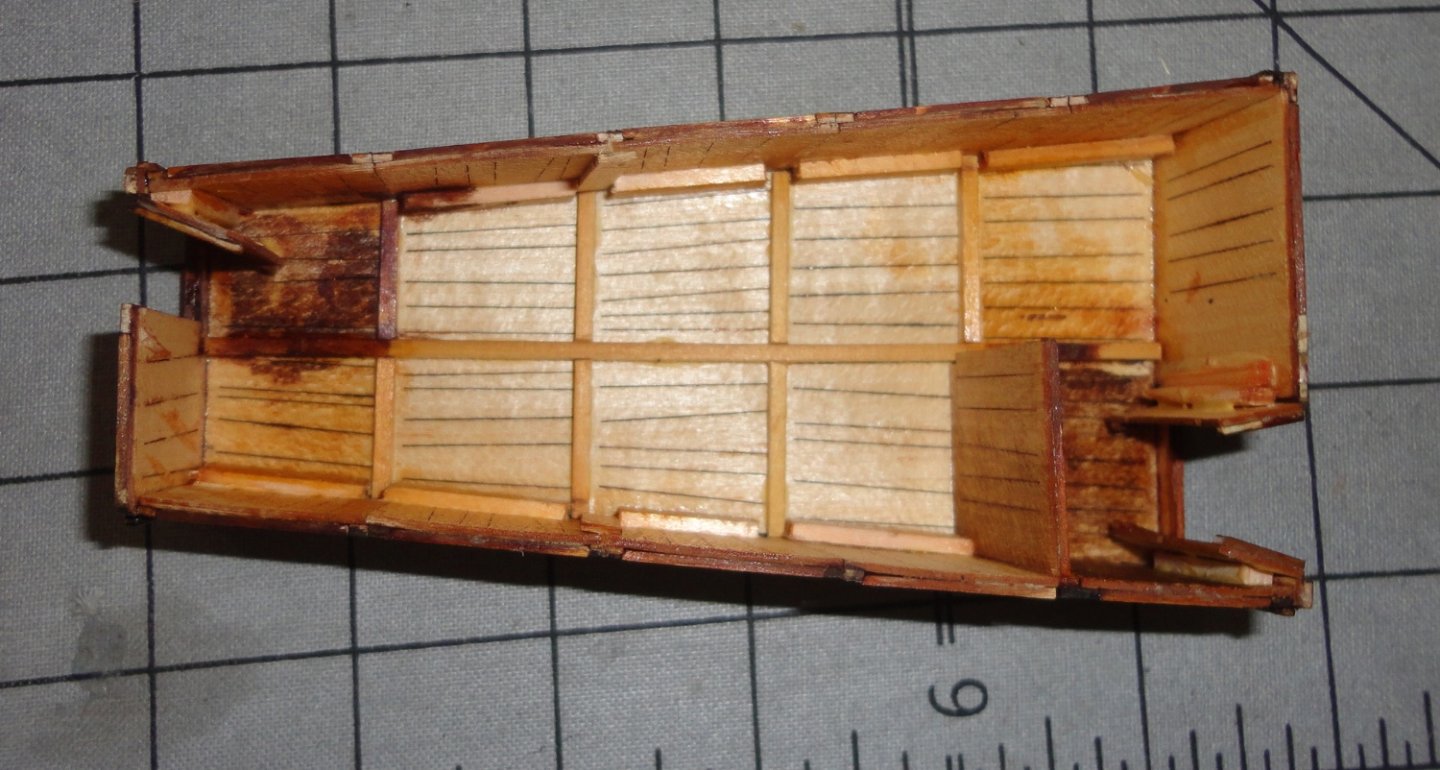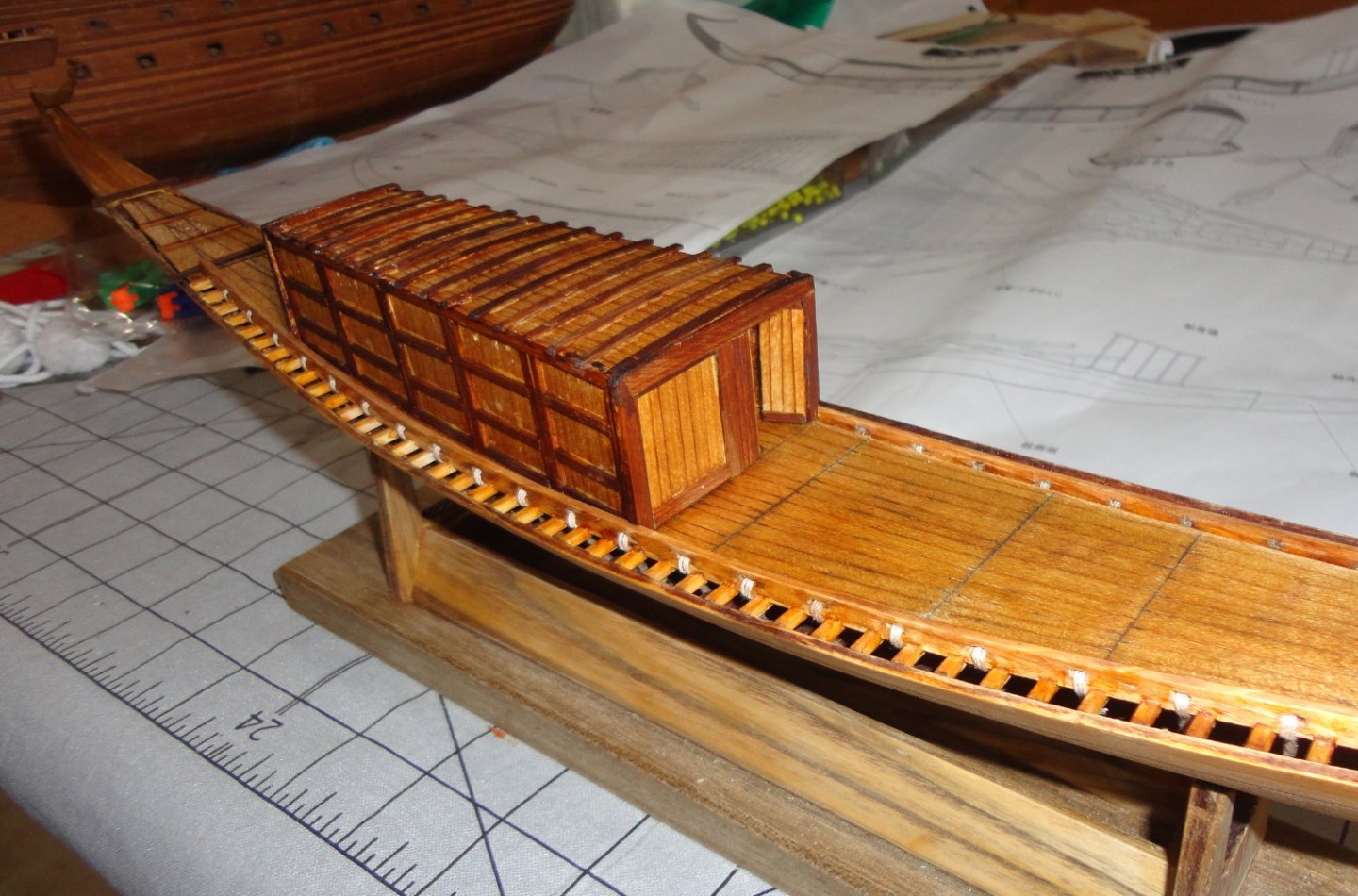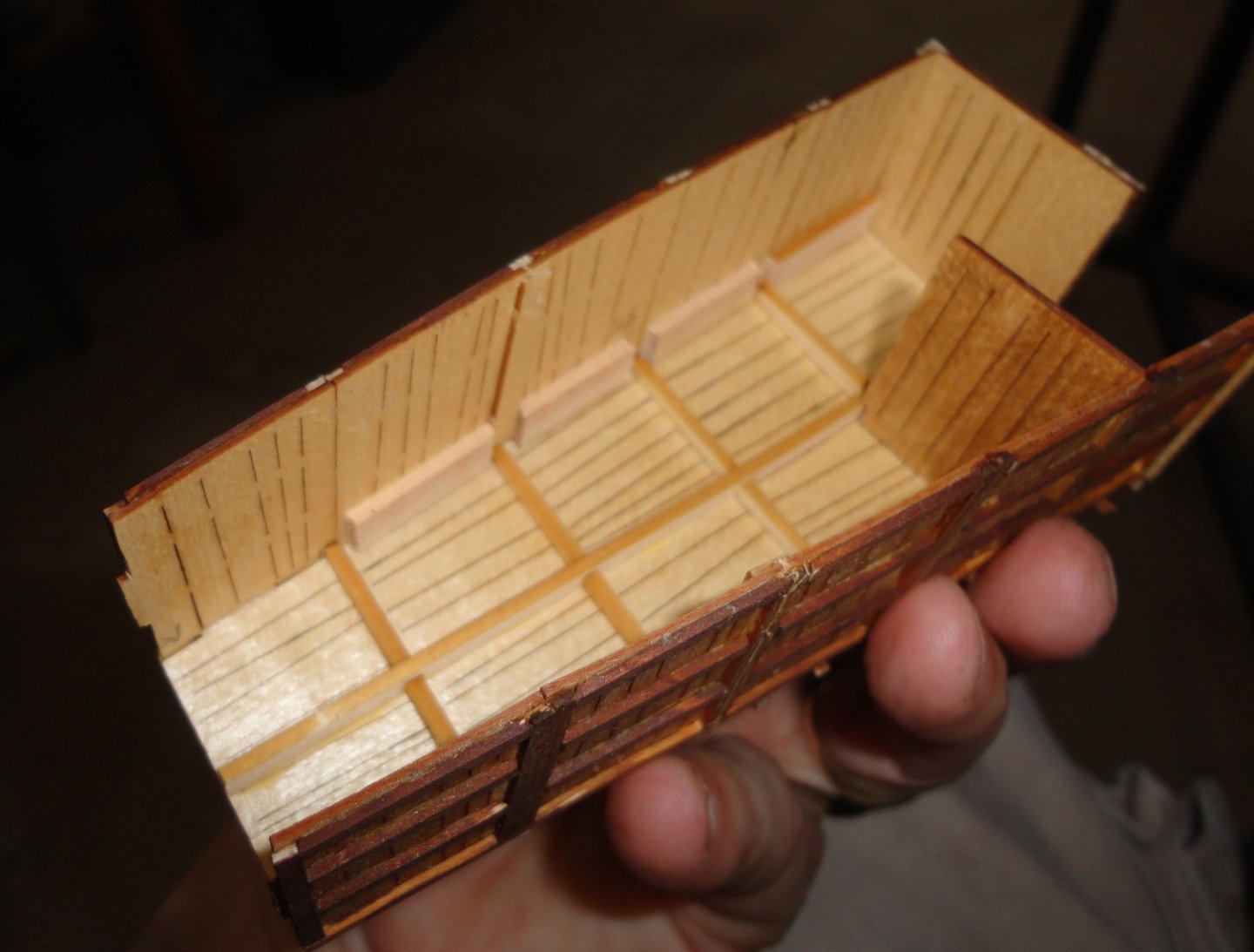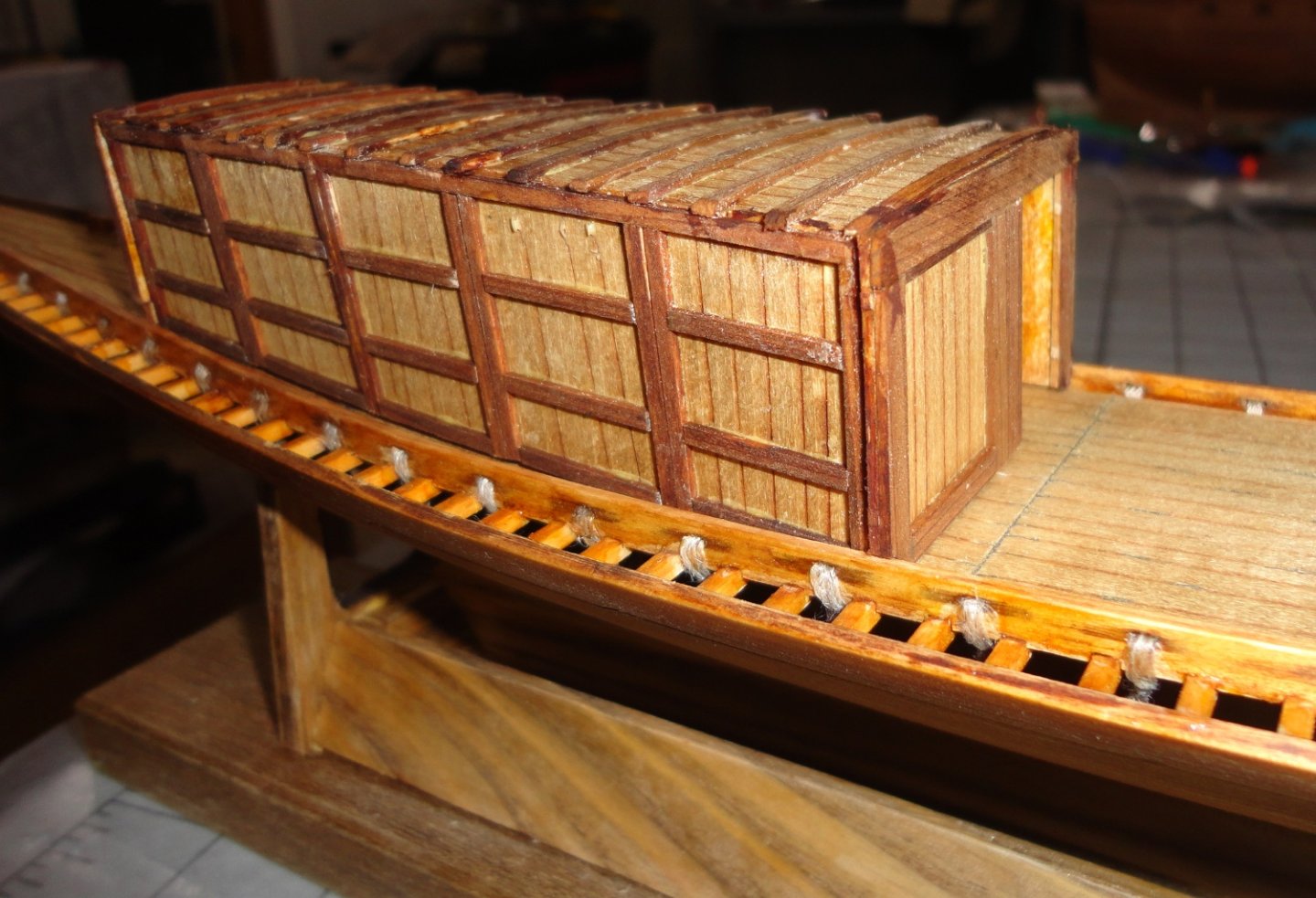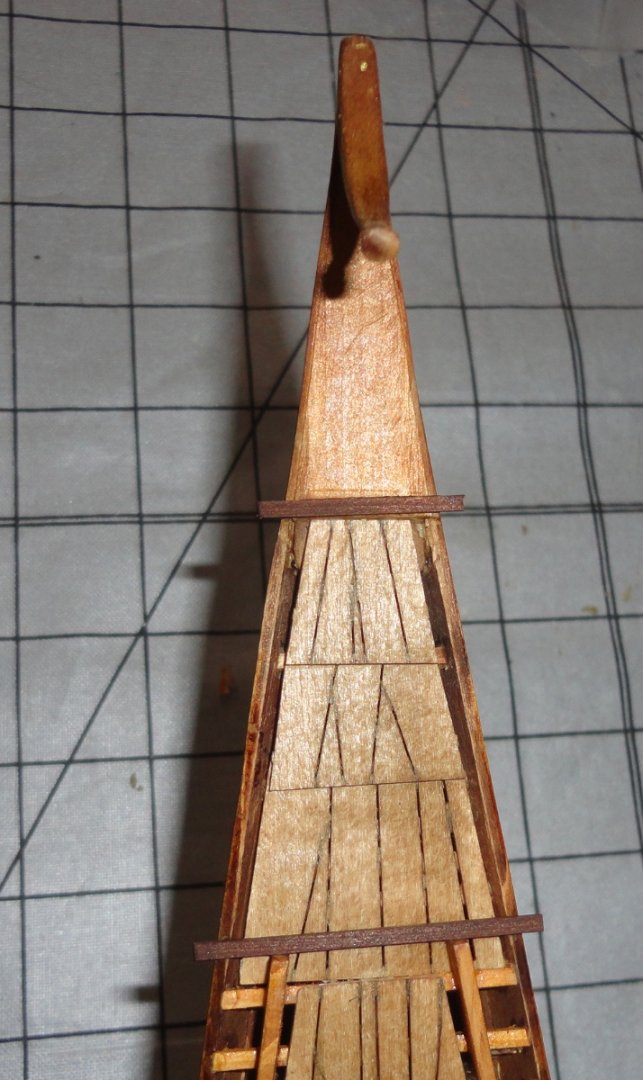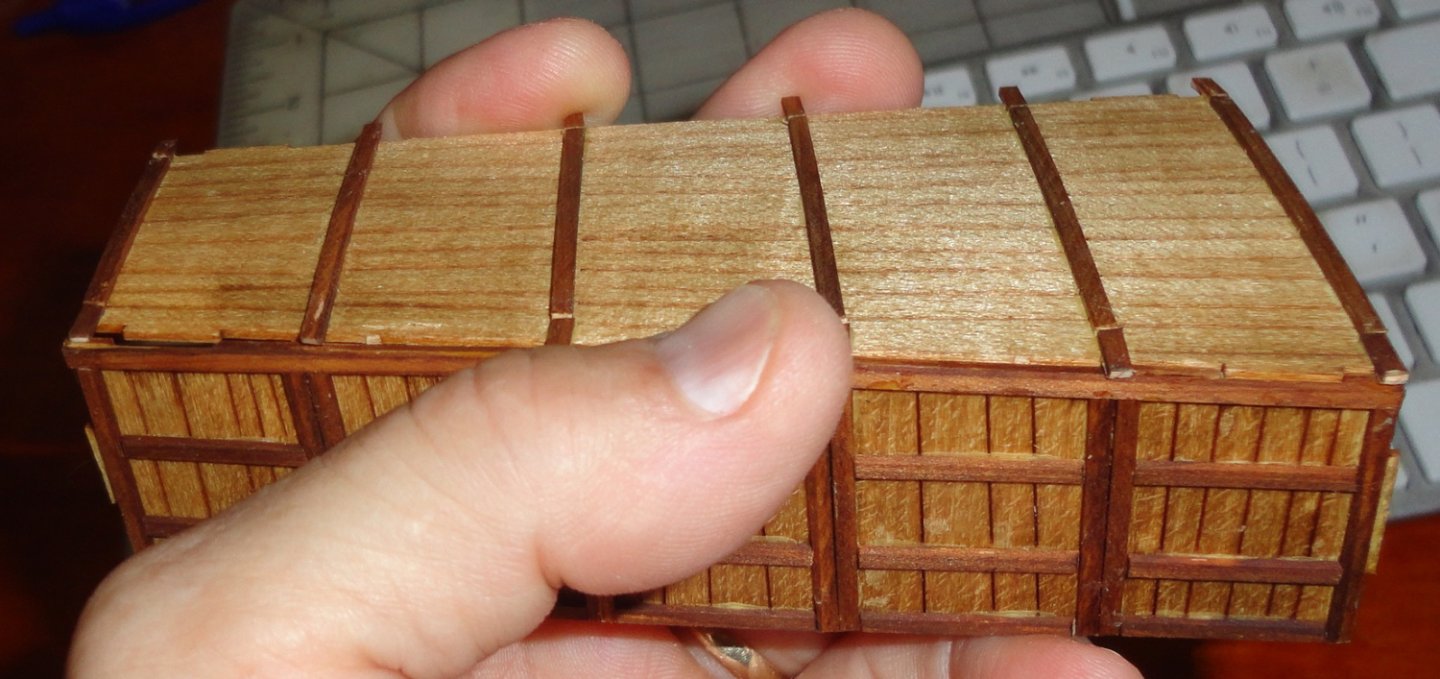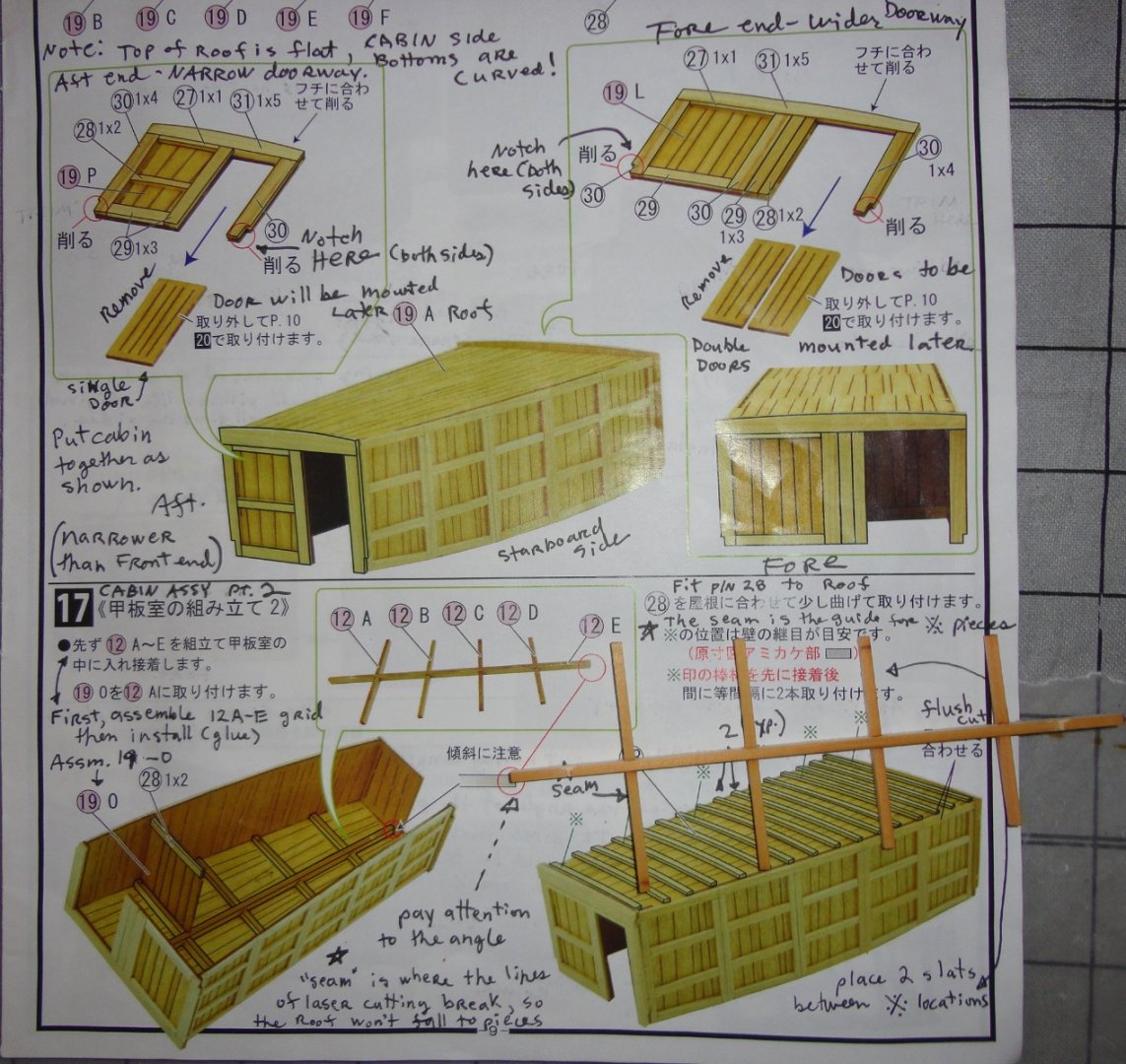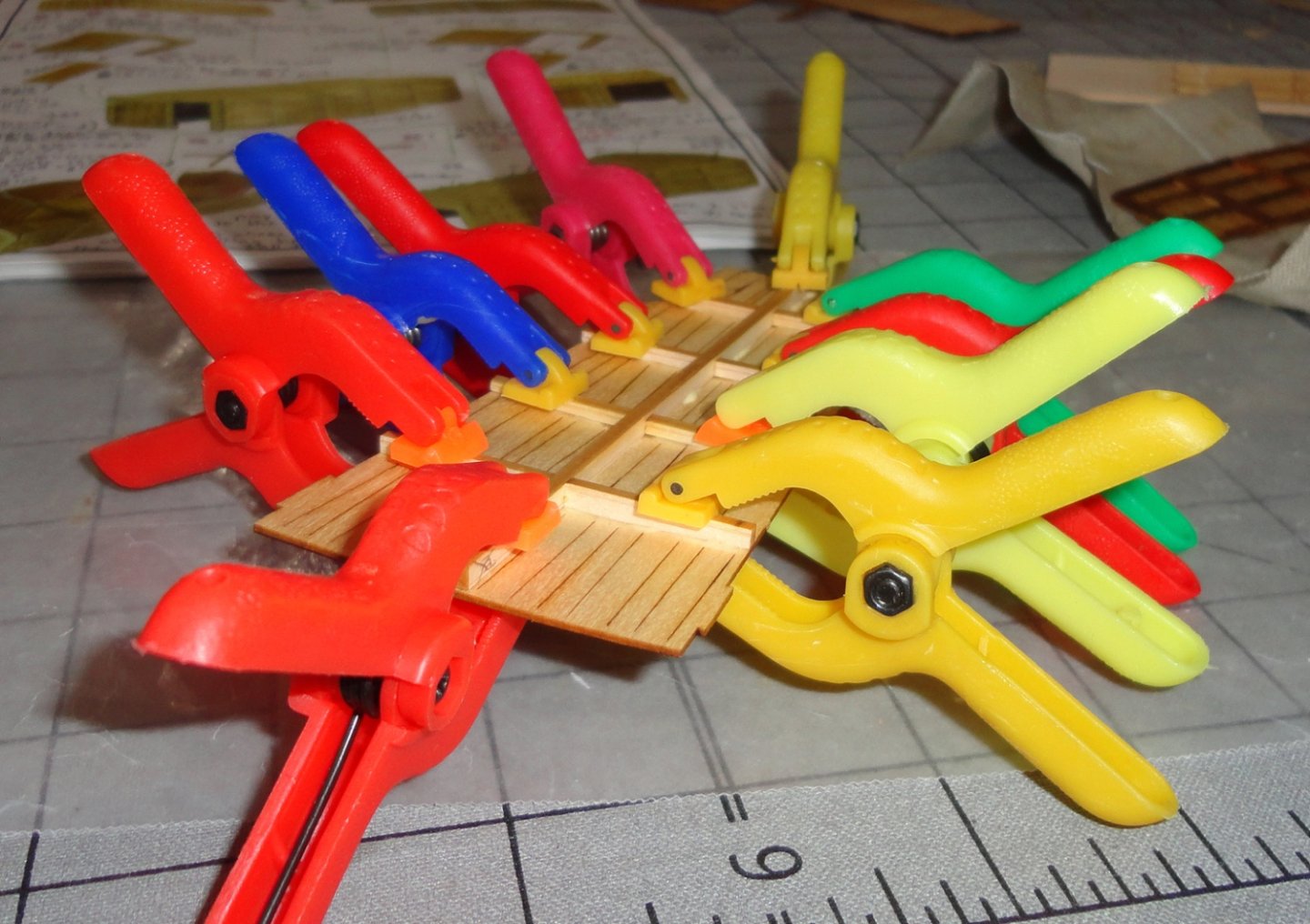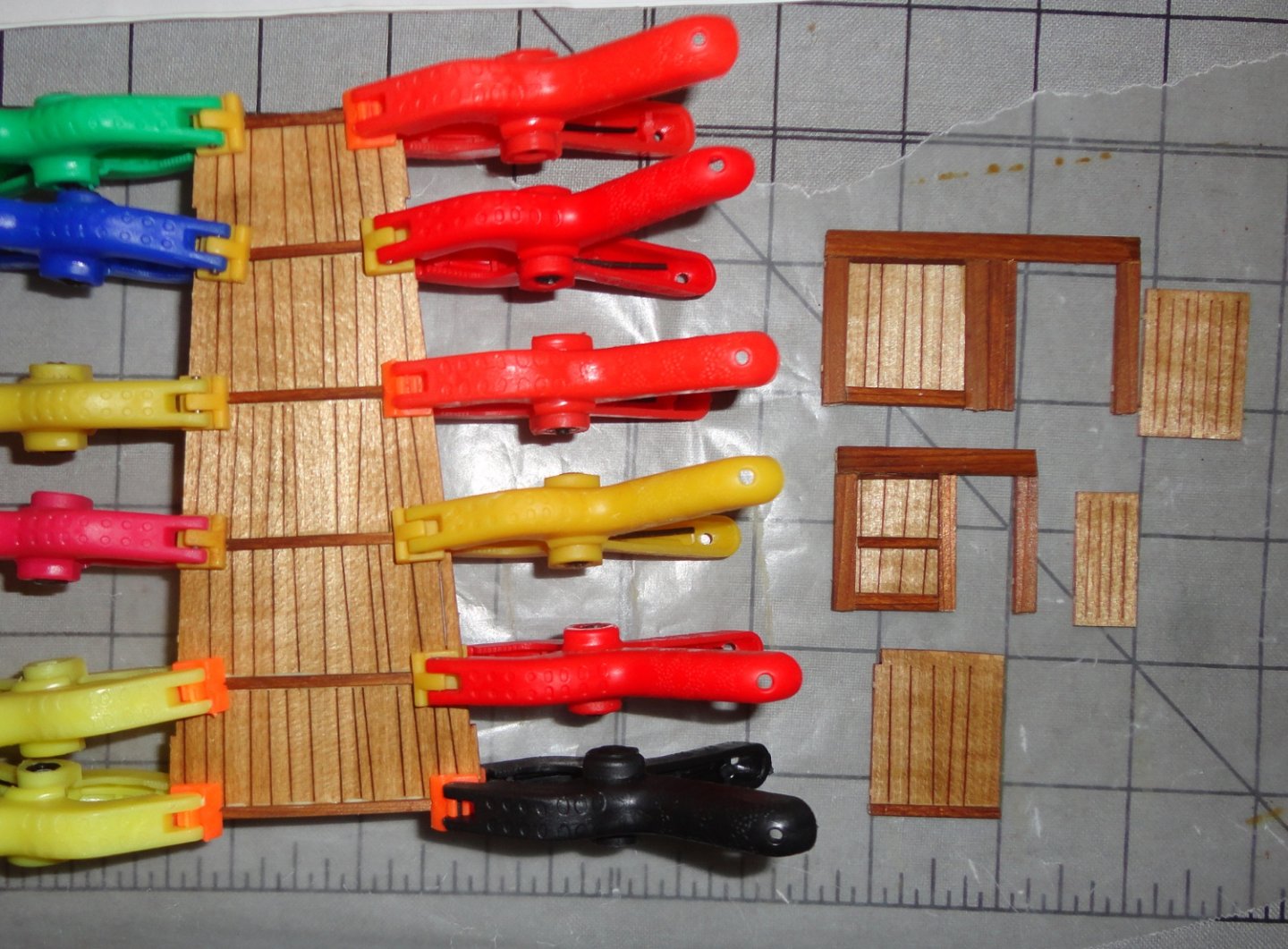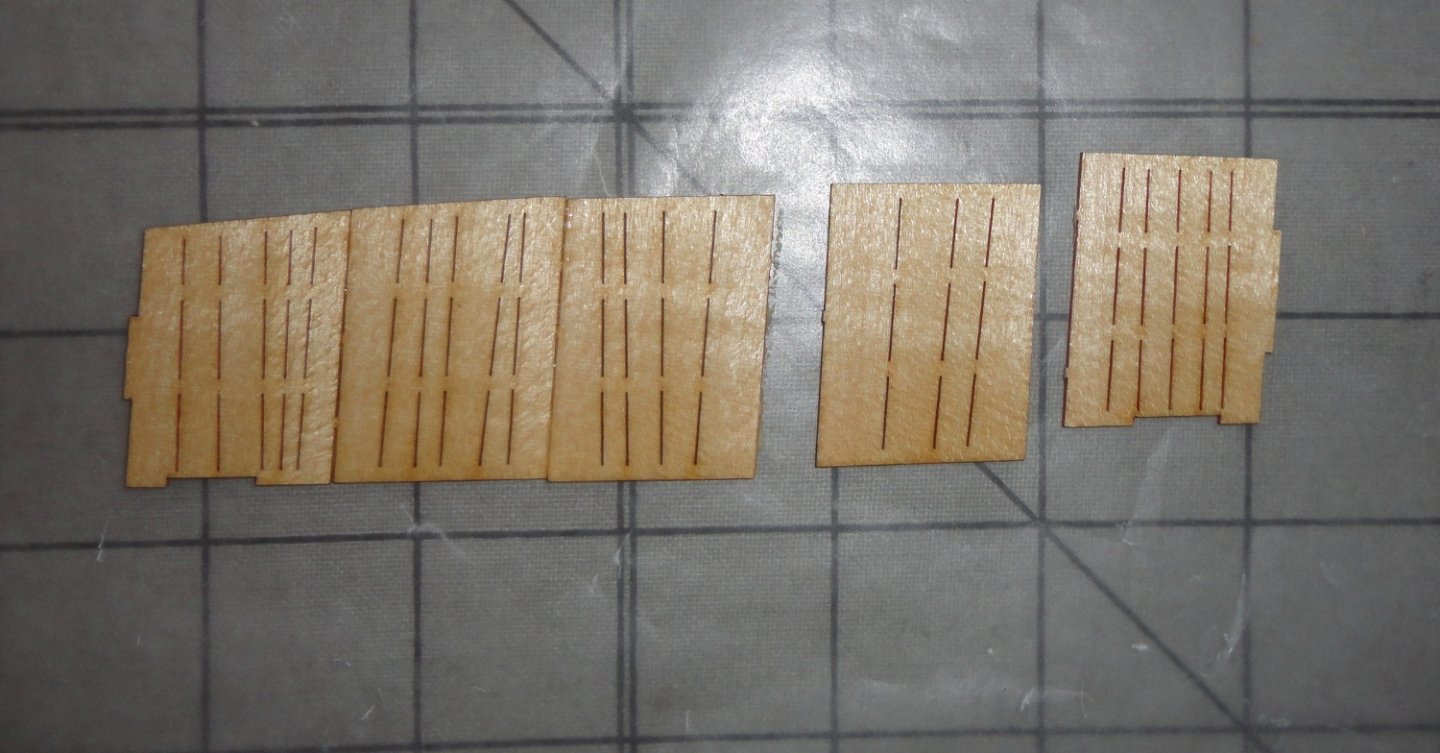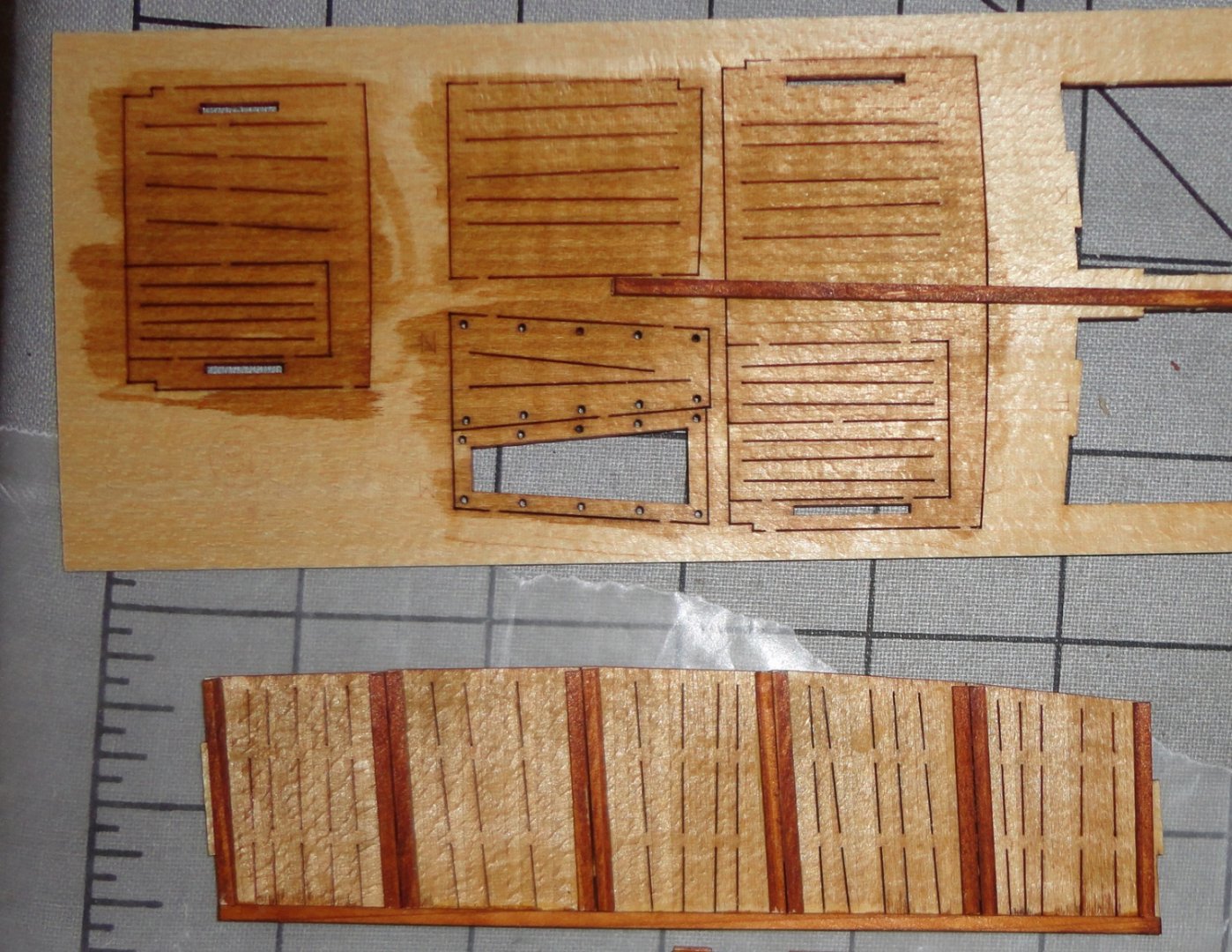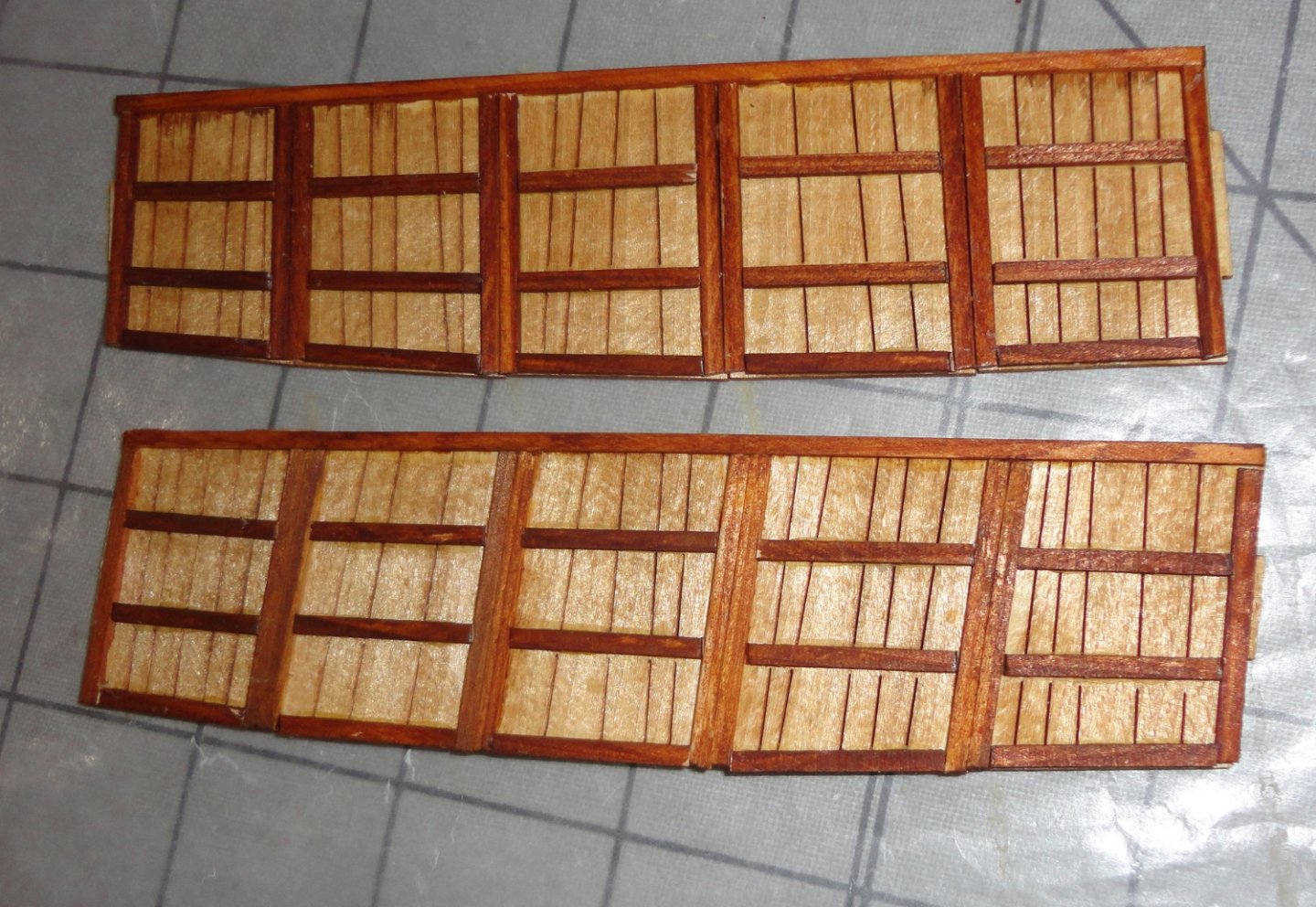-
Posts
1,453 -
Joined
-
Last visited
Content Type
Profiles
Forums
Gallery
Events
Everything posted by Snug Harbor Johnny
-
Your Robt. E. Lee was nicely finished ... congrats! Obviously the best visual upgrade was the HIS Models wooden decking, as plastic is notoriously difficult to paint resembling unpainted wood. Reals wood is ... real wood! Recently I chanced upon a Lindbergh version of the kit (didn't note the price) in a gift shop of a PA tourist cave (the Admiral wanted cabochons from the adjacent rock shop), and I'd later go through all the builds on the forum for all kits (using the handy shortcut list of links). Duh, it seems that here is another project that doesn't involve the sort of extensive rigging needed for 'mainstream' models in the age of sail (stropping blocks/deadeyes, shrouds with ratlines, lifts, halyards, braces, clew and sheet lines, ... ). A couple 'limited rigging models' are in my stash - Billings Roar Edge and Oseberg - and I'm 2/3rds done with Woody Joe's Khufu ship. So the Lee would also fall into the same category. (I'll take my dip into 'real' rigging eventually, perhaps with OcCre's Endurance - which has rigging of 'moderate' complexity.) While surfing Ebay, I found a 'vintage' Scientific Robt. E. Lee kit (unbuilt) for just under $60, while other listings for the same went up to $138. Lindbergh kits were about $60, but the wood deck upgrade is $70 ... so I ordered the Scientific version (photos of the box content were satisfactory) and should get it next week to add to the stash. It was quite interesting to compare and contrast all the Lee builds available on MSW. For one thing, there was some discussion as to what the 'actual' scale of the Scientific was - since the box printing states 1/8" = 1.45' . The model's full length is 24 1/2" (also on the box) ... and the original was 297' (3,564"). Divide 3,564 by 24.5 and you get 145.46. Hmmm, that rounds to 1:145 ! Perhaps a flub somewhere (or miscommunication) explains what got printed on the box. The Amati kit is about 1:150 (thus very close to the Scientific) but retails for around $400 new. Both kits have pluses and minuses, which I may go over if I do an unbuilt kit review of the vintage version. The plastic versions say either 1:163 or 1:164 (22" model). The Bluejacket version is supposed to be around 1:130, thus about a 28" length. Given the aprox. 100 yard length of the original, a 1:100 model would be about 36", but would have to be scratch built. Pick your poison , I guess. Johnny
- 117 replies
-
- Pyro
- Robert E Lee
-
(and 2 more)
Tagged with:
-
You show initiative to do a scratch build ... perhaps with the greatest satisfaction once complete - and the greatest learning experience. Don't forget the distinctive curve of Thermopylae's 'Aberdeen' bow - and the outward angle at the stern. The Cyril Hulme model is also from scratch (with input from surviving crew members). I note on that example that anchor chains go quite far back on deck before descending below deck. The gunwales are wide enough to mount the deadeyes without protruding channels - ditto for a similar model in the Aberdeen museum.
-
Ahoy, mate! You'll likely find a world of info scattered throughout the form. You can use 'search words' in various ways to find likely build or discussion logs on the ship or topic desired. There are also indexes of build logs by time period/ship. Have fun! Johnny
-
Hi Demostenes, With some searching (and patience), a copy of Hackney's #3 (Cutty Sark) was purchased. I've noted else where that this series was done with the help and promotion of Airfix models - who made the plastic kits that are covered by the Classic Ships series. Hackney covers a standard build, optional modifications, "Harbour Rig" and full-sail rig. So there are four basic combinations ... each requiring a certain order of assembly - and some modification/rigging steps may also be omitted or further modified. To do this with the least number of pages (thus cost to publish), the book may be compared to a 'compressed file' because a complex lettering, numbering and asterisk coding scheme is used throughout. Thus the builder must first decide WHICH version of the ship/rigging is to be done, then must flip back and forth to get all the pertinent details. Actually, it is on my 'to do' list for me to go through my book slowly and ferret-out all the applicable paragraphs/steps for whatever version I end-up deciding on building, then put them all in the proper order for my configuration ... which amounts to a 'decompression' of the data. As a former manufacturing engineer (and a present Pharmacy Technician), this de-coding does not present too great a conundrum. The book's illustrations/schematics are invaluable, yet leave the reader wishing that there had been more of them for greater clarity. I found that the Cutty model in question is only 1:150 scale (an kit was ordered from Korea 'just to see'), and very difficult to incorporate the extensive detail laid out in the text of the book. Yet for a 1:96 model of either Cutty Sark or Thermopylae, the modifications/details may be reasonably accomplished. Hackney's book may also assume some prior knowledge or exposure to Nautical terms - hence there are several other books noted elsewhere on this forum that are helpful in this regard. Keep your lantern lit ... Johnny
-
What scale did you choose? Keeping to a scale determines the sizes for deadeyes, blocks, belaying pins, rope, etc. At 1:96, the 9 1/2" shroud deadeyes (ok, I'll use 10" or 250mm and 1:100 to make the math easier) would be represented by 2.5mm - with the backstay deadeyes at 2mm (even smaller aloft). These are devilish to work with, so no wonder many choose to go at least a little 'out of scale' for manageability. HisModels supplies 3.5mm in the 1:96 Cutty accessory set, which would translate to about 14" in real life! Of course the (aprox) 1:72 scale kits (they vary slightly) make for a 4' (overall) model (versus 3' at 1:96), but the 3.5mm deadeyes would be very close to scale. A compromise scale would be 1:84, and one can get away with the 3.5mm shroud deadeyes (just over 11" in real life) ... 'close enough'. Let's see, the backstay deadeyes would be 3mm, with 2.5mm for the next higher section of masting - and perhaps a few at 2mm highest up. That made me consider getting an Artisan Latina (AL) Cutty kit in 1:84, then 'bust' it to become the Thermopylae. All the hardware and materials would make that much easier than a straight 'scratch build'. Of course, one must pay for the kit. There are a few builds of that kit in the forum, and the critiques include too few bulkheads for single planking. OK, making more bulkheads - or even pairs of half-bulkheads - wouldn't be too hard if one goes by the available lines. More bulkheads = easier single planking (perhaps with wood filler blocks near the bow and stern). The deck planking is done 'on the flat' before installing bulwarks (not a bad way to go - and OcCre has models using this approach). Deck planking can be done on the plywood under-deck entirely off the model (as with the Endurance) so that deck eyes and some other stuff can be secured right through the deck to prevent later pull-out during rigging. Still there are challenges, and I can experiment with the OcCre Endurance (presently in my stash) - my next build after completing the Khufu barge.
-
BTW, on page 8 of the Cutty Sark by Bruma log, there are three posts showing a method I used to represent a clipper sail furled, with 'dog ears' (some call the mouse ears) hanging. The proof of concept used paper (versus fine cloth or silk span) folded as crewmen would haul up sections over the yard (after the bottom corners were raised by the clew lines) as they stood on the foot ropes and leaned over they'd to grab each section. A narrow rectangle was used, with a trapezoidal portion cut out of the bottom center so it would not 'bunch up' too much on the yard. Split topsails or topgallants were comparatively narrow rectangles anyway, but even a main sail compresses enough in real-life to look like almost nothing is on top of the yard - thus a narrow rectangle so folded can still look OK furled on the main yard.
- 444 replies
-
- Cutty Sark
- Revell
-
(and 2 more)
Tagged with:
-
Kevin, Rob is right-on with innovative ways of doing (or not doing) things. From pictures of actual clippers (then and now), furled sails don't look like there's much there, so very little material is needed to represent them. Laid on top of the yards, (as Rob has done) the bunched fabric completely covers the jackstays ... so you don't need to do them at all in that case. Gammoning rope keeps the furled sail on top of the yard, where any rain will just roll off. Rob shows bunt blocks, but a furled sail could just as easily cover them as well as the jack stays, so only the bunt lines will come out from under the furled sails and go the the blocks at the mast to be routed down through the appropriate fairleads. Another thing you could get away with not doing (via furled sails) is to 'forget' about luff lines ... they won't be missed. As a ship so portrayed would be dockside, the yards can be tilted to one side - meaning that the model can have a narrower display case ... that can fit on a narrower shelf. The book 'Cutty Sark' in the Classic ships series (Their History and How to Model Them 1974) ... out of print but they can be had now and them as used books (author Noel C. L. Hackney) deals with an Airfix 1:150 scale plastic model. Although an extreme challenge at that small scale, most of the modifications (additional eyes, etc.) apply to the 1:96 Revell kits ... although to take advantage of some of them, they must be attended to while building the hull. YET, the rigging diagrams and supplemental sketches (wish there were more) provide a 'blueprint' of how to proceed with rigging. I note elsewhere that this book resembles a 'compressed' file, as one has to flip back and forth to make any sense of the contents. The author tries to cover simplified v/s detailed hull assembly with either 'standing rigging' (he calls harbor rig) OR fitted with complete sails. Before proceeding with a future build of the Thermie (to be rigged the same as the Cutty), I plan on ferreting out the relevant information and re-arrange it in the order of assembly for a clipper in port with the sails furled due to an anticipated short stay.
- 444 replies
-
- Cutty Sark
- Revell
-
(and 2 more)
Tagged with:
-
Ahoy, Brian ! Back in the day, I designed tooling and modifications to industrial pipe bending machines - so I've some mechanical engineering experience. The twin rudders (and their tillers) would logically move in tandem, and the best way to assure that would be to have a bar connecting them. The ends of such a bar would have either a yoke on the ends or would be slotted to fit the flat metal end of the tillers. A thru pin would complete the assembly (with a cotter pin, ring or nut to retain the pin), and steering force would be evenly transmitted between the tillers while maintaining the pre-determined distance between them (assuring identical rudder angles). That's the way I'd have designed it, and said bar would likely have been bent or otherwise deformed in the intervening century or so. Obviously, beyond the tillers a flexible means of control was required, and wire rope seems the most appropriate to have been used (easier on the pulleys in the drawing - a reason that wire rope was used when elevators and cable cars were invented). End yokes to the central bar would extend slightly beyond the tiller to allow for a second thru pin. The ends of the wire rope would be formed into 'eyes' (several ways to do that) to engage the thru pin. You can model wire rope with dead-black miniature rope.
-
Ahoy, Simon ! Many libraries are 'de-accessioning' book in droves. I bought a copy of 'Cutty Sark' in the Classic Ships - Their History and how to Model The series by Noel C. L. Hackney (1974 printer Patrick Stephens ... in association with Airfix Products Ltd. - aha, they made the plastic models at the time). Kept 'thin' to hold down printing costs, its kind of like a 'compressed' file ... just bursting with information, but organized with a logic depending open how one wants to build and rig the model ... so I have to constantly go back and forth to cross-reference whatever detail I'm is trying to clarify. It also needs more diagrams, although the drawings included do help. The model in question is listed as 1:130 in the book and may not be produced anymore ... but somewhat small (at least for my fingers and eyes) to do the kind of detailed rigging set forth in the book. YET, for a larger scale (say, 1:96) it is quite doable, so I plan to 'uncompress' the file somewhat to get a 'road map' useful for the Thermopylae as well as the Cutty. Opening the cover reveals a side-view related to the text, and a Library stamp for the Jervis Public Library Assn., Rome N.Y. ... so at first I feared that it might have to be returned to the library. But in the back is the 'pocket' where the book card used to be, an accession date of Sept. 23, 1976 (acquisition cost of $5.95 ... I paid much more) and a record that the book was lent only once with a due date of June 1, 1988 ! There was a library stamp that the book was "Discarded from Jervis Public Library Rome, N. Y." ... most likely in a mass book sale. It a good thing the book was officially released from the library, because there is a fine of 5 cents per day charged for each day the book is kept beyond the due date stamped above. Some day long hence, when most of the libraries are gone and the 'cloud' goes away due to some war or catastrophe, will we enter another "dark age" ?
-
You've picked an excellent ship to study, mate. It's a future project for me, but not for some time - ergo I'll watch with interest whatever you may post on the Thermie. So many have done the Cutty Sark (quite understandable since she still exists), but there are just a few builds on the forum of Thermopylae ... all of them worth a look at. Both clippers had the same hull length (about 212' 'between perpendiculars'), but Thermopylae had the graceful 'Aberdeen bow' (versus the sharp angle of the Cutty) and the stern profile had an outward angle (CS looked closer to vertical above the rub strake). 1:124 is a tougher scale (see the log by Popeye the Sailor of the Sergal kit of the Thermie - and the old Scientific kits were around the same scale), and its harder to keep many details 'in scale'. Hull size is around 21" at 1:125. The 1:96 plastic Revell kit (adapted from their CS) goes only so far, and I'm uncertain whether its worth trying to correct the deficiencies (there is an unbuilt kit on my shelf). Yet some of the components (like the pulleys, pump and winch) might come in useful on a wood build at that scale. See the build of the Glory of the Seas in 1:96 by Rob Wiederrich, who uses pulleys from Revell kits of the same scale. The extreme composite clippers had internally stropped pulleys, so using the ordinary sort of wood pulleys would have them externally stropped with rope, whereas the Revell pulleys are good as-is (internally stropped with an iron ring represented on the end). Hull size is about 26 1/2" at 1:96 EDIT: The mfgr. used 212' as if it were 'on deck' to arrive at this scale. Since the registered length was between perpendiculars (cutwater at waterline to center line of rudder post), the hull scale is actually 1:100. Yet even those might be a wee bit 'out of scale', so would be great at around 1:72 or so. A CS or Thermie hull in the larger scale would be around 36" (not including bowsprit) ... 1:84 would have about a 32" hull. So it's hard to make a choice sometimes. Once can get a wood kit of CS in the larger scale, and the conversion to Thermopylae would be easier to accomplish. Many items (pump, winch, etc.) would come in the kit instead of having to scratch build. The best of luck at whatever you choose to do !
-
'Just had to think about the problem some before a likely solution came to mind. The battens glued to the outside of the cabin walls (stained darker) are a source of interference near the ends. So why not sand them down where needed? They are of 1mm x 2mm cedar stock, so the thickness can be reduced by half, and they can be re-colored. I used my sandpaper covered hacksaw blade as a handy tool. 'Still needed some more relief, so I filed round grooves where the vertical canopy supports will go. The cabin was a little wobbly on the deck, so sandpaper was put on the deck, and the cabin was rubbed against to hit any 'high points' ... the result was a much better fit. The notches at the bottoms of the stern facade were filled to adjust the exact location of the cabin a little. Then I set the works on the model stand and found that the end verticals will nest between the cabin wall and deck rail just fine. So far, so good. Now I have to make another 40 verticals (plus some for the little pavilion that will go farther forward on deck), then make an altered plan view of the canopy frame - which will only go a little further beyond the cabin roof as seen on the original - and build the frame. Then the verticals can be pinned and trimmed to length.
- 63 replies
-
- Finished
- Khufus Solar Boat
-
(and 1 more)
Tagged with:
-
I'd like to keep the end hole in the supports small, and trying a center support wouldn't stop the length from springing. The best results (not clear in the picture) is to turn the wood close to the chuck (no more than 1/2" at a time) before advancing to do a little more. There is still post-processing ... these supports are also a little out of scale. Now the problem: The original ship does have wood at the ends that 'notches' to the side deck rails ... which fixes the position of the cabin nicely. But note that the walls of the cabin have room for the vertical canopy supports to fit between the wall and the side rail - even at the ends. Towards the middle where the rails bow out, there is more room - and the verticals tilt out some, so that the bases are against the inside of the rail (and cannot slip out). Another picture from a lower angle showing the cant of the verticals in the middle section of cabin. Now look at what I have on the model at present. Verticals can just fit between the cabin wall and the side rail ONLY in the middle section - and then they must be straight up (not canted, like on the original). They are still longer than needed, and will only be trimmed when trial fitted ... but they cannot fit into the gap fore or aft of the two shown. The end facades are OK with the notch, but the walls should be about 1/16" more away from the side rails. This is a subtle effect that would have required much forethought ... perhaps taping the cabin together with blue tape for a trial fit (as well as deciding on the method to make the canopy frame verticals) and finding this out. Even so, the end substrates were already glued to the end facade wood. The underlying end pieces would have had to be trimmed back in width on each side when originally built (and also the top piece, carefully keeping the contour of the tabs) - so this fit problem was likely unforeseeable. Someone doing this kit who sees this build can likely take the steps to correct the oversight in the kit design ... the door(s) on both ends also shift slightly - making the cabin build a touchy thing. Internal blocking in the corners would also aid assembly. I moved the cabin a little to the side to simulate where the cabin walls should be. Not straight, but you likely get the idea. But now I can't go back on what I've done, and must look at the alternatives. #1 will be to place the bottoms of the verticals on top of the side rails ... and this is implied on the drawing, as the overhang of the many sideways canopy stringers go out as far (seen from above, aka 'top view') as the side rails. #2 might be to place them on the outside of the side rails - and a thin rope would have to be go from the existing holes in the rail to pass over the verticals to 'retain' them ... still they seem precarious sitting on narrow deck beams. #3 would be to shave the bases of the verticals enough to 'force' them into the gap near the cabin ends (where there is almost no gap). Perhaps some discreet whittling of the cross bracing wood at the base of the cabin wall where each vertical has to go might be done. The modification would not be obvious with so much going on elsewhere on the model - especially once the canopy, oars and figures are added. BTW, the rail 'tie downs' done with flax thread are decidedly inferior to the tie downs on the other side done with miniature rope I made on the Rope Rocket. As I said, this build offers a learning experience. My inclination is to go with option #3 as best as I can manage, as that will appear closest to the original.
- 63 replies
-
- Finished
- Khufus Solar Boat
-
(and 1 more)
Tagged with:
-
'Looks like after the blocks and tackle are used to run out the gun, they are not made fast - and the line is left loose on either side. When fired, the recoil is slowed (energy absorbed) by the loose line racing through those pulleys as the distance between them (under strain) increases ... sort-of like "brakes". Then the remaining force is checked when the thick line goes taut. This constitutes a recoil 'system'.
-
Old Johnny's been doing too many things lately, but thinking about what is described as 'palm' capitols on the canopy supports (somewhat like the capitols of pillars in the hypostyle hall at Thebes) I've decided that 'rounding' the 1.5mm x 1.5mm stock provided inboxed the kit (while adequate) may not be the best way to go. The cedar stock is so thin that its quite quite bendable ... a little too much perhaps. Rounding all that can be tedious, with the risk of too much removal and too much irregularity. But then, many aspects of this hobby can appear 'tedious' to the casual observer. So a universal three-jaw chuck was put on my Unimat to try and turn the supports from 1/8 hardwood dowel (found in an old-style hobby shop). Other vendors like Hobby Lobby may have it with other wood stocks. The long dowel goes right through the headstock like it does on a full-sized lathe, and the concentricity of the Unimat chuck seem right-on. With the dowel advanced only a little, the tailstock with a pin-chuck head (meant for drilling) and a #60 drill was used to put a hole in the end of the dowel about 3/16" deep. The tiny drill was a little wobbly, but the hole ended up close enough to center for my purposes - to accept the pointed end of a brass escutcheon pin without splitting the dowel. Then the dowel was advanced some to turn the 1.5mm shaft (target somewhere between .060 and .070) partially, since the end is not supported and there would be too much deflection if it was worked too far from the chuck. Sequential advancement of the stock permitted turning more until an oversized length was achieved (to be trimmed during trial fitting as needed). OK, I realize that this piece of equipment will not be in the toolbox of a beginner ... perhaps an electric drill mounted on a horizontal drill stand (purchased or home-made) might spin a piece of stock to be sanded at a moderately slow speed with a folded piece of sandpaper? Alternative 2 might be to use 1/16" diameter toothpicks or match sticks as the verticals, then drill-out 1/8 inch dowel to cut-off short pieces to glue onto one end. One may need to be creative - or just round the 1/5mm square stock from the kit. I had to use a small file to form the capitol on the end - so I'm thinking about making a form tool to do that on the lathe. Below is a view of the end-hole drilled in step 1. So now I've done 4 of the anticipated 48 needed, and at over 10 - 12 minutes a piece I may take between 8 and 10 hours (altogether) to do the lot. They are still a little rough, and I may fuss with them some more. Today some 1:72 Egyptian military figures arrived (bought on Ebay) and enough of them can be modified to put on the barge. There is one Pharaoh, a couple of attendants and one drummer - plus various men at arms that I want to modify into standing oarsmen. 'Guess careful heating and some re-modeling with a heated dental tool can do the job. They'll all be painted. This model is somewhat off the 'mainstream' on the Forum, so why not add some figures? I did see a source for seated Egyptian oarsmen, plus an overseer and standing steersman made in several scales via a resin solidification process done in an Eastern European country ... but without paying $$, the production-to-order would be 2-3 weeks plus slow shipping. My payment information would also have to go to the manufacturer. Buying through a trusted third party like Ebay, Amazon or ETSY is safe, as it can be done by credit card as a 'guest', and the seller never sees personal information (other than the name and address to ship to). I'm reluctant to do business otherwise.
- 63 replies
-
- Finished
- Khufus Solar Boat
-
(and 1 more)
Tagged with:
-
'Just got the idea to look for some 1:72 ancient Egyptian figures to put on deck. Given the popularity of several scales of historical figures used in gaming and dioramas, I might be able to scare some up. That will affect how I decide to configure the oars. Maybe they have a Pharo (Kufu may have used this yacht while still alive), or perhaps an 'inner coffin' brought on board post mortem. The immense sarcophagus was already in place inside the pyramid - with the King's chamber built around it.
- 63 replies
-
- Finished
- Khufus Solar Boat
-
(and 1 more)
Tagged with:
-
The cabin doors needed top and bottom battens, so they were glued in place. It seemed best to install the open door IN the cabin first while there is access from the bottom ... and scrap material was glued behind the doorframe sides where a door will hang, so there is something to glue the door to besides the frame. Again, nothing in the instructions about this, but it seems a useful thing to do. The picture below shows the clamped pieces. After curing, the wood behind each doorframe was trimmed and the door test fitted to judge the angle. The doors were glued and appear in the picture below. I slopped a little color inside where it might be possible to see from the outside once installed. The cabin was given a light coat of shellac and placed (without gluing for now) to the deck to see how it will look. I'll tape the two plan sheets together to make one large sheet, so I can frame the canopy right on the plan ... not unlike building a model plane many, many years ago (won't say how many). This build has gone reasonably smoothly - with just a couple of digressions/modifications. Each step has me thinking on how to proceed, so I generally ponder it while doing something else. That's why its helpful to have more than one 'pot on the fire'.
- 63 replies
-
- Finished
- Khufus Solar Boat
-
(and 1 more)
Tagged with:
-
'Found that the cabin pieces were definitely tricky to hold together. First, there were many trial fits - each time I had to see what needed sanding or tab trimming so that things would fit properly (squarely). Then it was still a bit 'rickety', so I glued some stabilizing battens along the top of the side pieces. These had to be positioned 'just so', and I used wood glue. I couldn't figure how to clamp everything ... or even if I should attempt a single 'mass glue-up'. Well, the decision was to hold it all together with one hand, then make sure one corner was fitted just right - then use CA to 'tack weld' that bit. The 'thin' CA tends to 'wick' its way quite a bit, so I had to hold the workpiece so that a near lever applicator tip could release the smallest amount. This stuff can be 'wicked', and wants to stick to fingers like crazy. I kept an open tin of acetone handy to get off any as quickly as possible. The stuff gives off some sort of gas while curing (within 10 seconds), so I'd blow that away. Yet the process is exothermic, and I could feel the heat of the joining. So then I'd go on to another point, etc. etc. 'tack welding' as I went - then finishing the in between joins with CA. The result was OK, and the small notches at the base of the end pieces (both sides of each piece) 'fit in' to the deck side rails within a narrow range - exact location to fix will be determined by (duh) consulting the drawing. 'Doesn't look too bad at this stage. I'll figure how I want to mount the doors and apply the top coat of shellac. I'm thinking that I'd like the canopy framework to be pinned together (might be better than gluing). A method of making better 'lotus' style canopy supports is still being debated. BTW, I found that the side rails (as laser cut) have (just astern) one of the rails slightly longer than the other. This makes one of the steering oar mounts a little crooked ... 'don't know right now if I want to bother 'fixing' this - and tilted the rearmost one to match. But it is something to check for anyone else doing this build. A previous builder noted this kit is 'easy, but not too easy' .. I'll second that opinion - as there is some good exposure with wood bending, gluing, etc. - and I needed some skill building in this area. Luckily this project doesn't have a lot of rigging to do. 'Thought I was an 'old salt' before starting ... but it seems that I'm not as salty as I imagined. Hmmm, though the Admiral thinks at times I'm a 'salty dog'. Rruuh - rhrooh.
- 63 replies
-
- Finished
- Khufus Solar Boat
-
(and 1 more)
Tagged with:
-
Gosh that rudder looks swell ... I'll have to try an emulate on another project of mine, where I've been 'stuck' for awhile.
- 179 replies
-
- santa maria
- mamoli
-
(and 1 more)
Tagged with:
-
'Absolutely LOVE all the details you're including, mate. If I ever do a movie ship, it might be the pirate ship from Hook, with Dustin Hoffman playing the title role ... he was perfect. Then I'd have to equip his cabin with all those red-heeled shoes in one cabinet, a miniature ship floating in a large bowl, etc. (and a miniature of Hook and Smee) and make the skull-like stern decoration hinged so one can open it to see the interior. Hook (holding pistol to his head), "This time I'm going to do it. Stop me, Smee. I'm really going to do it! Smee .... SMEE! Stop me, Smee." 😉
-
'Saw a good tip a couple places buried in the forum ... Clove hitches for ratlines are typical on the inner shrouds. Since an eye splice for each ratline atr the outermost shrouds is impractical in most scales, many just do another clove hitch. But that leaves a cut end protruding (even if just a little) on the outside of the outermost shrouds (the end of the run for each ratline). By using a cow hitch, the end of the line points to the inside, where it isn't noticed - especially if glued to the ratline. Bravo that you're using dark line for the ratlines and deadeye sheaves - all part of the standing rigging, therefore treated with some sort of tar/solvent mixture. There were several versions. Clear sailing, mate! Johnny
- 163 replies
-
- Model Shipways
- Constitution
-
(and 2 more)
Tagged with:
-
Two steps forward, one step back. 'Seems the sides ended up about 1/16" longer than the roof of the cabin - even though the laser cut pieces glued edge-to-edge to make the sides butted closely. Hmmm here is another tip for whoever builds this kit - in that when laying out the sides, the butting edges need to be sanded just a little. Then the top piece (with tabs) can be used as a gauge to see if the combined length of the side pieces has been adjusted properly. So what I had to do is cut both side pieces at a seam, sand those mating edges equally and check against the roof assembly to judge when the right amount of material removal had been achieved. Then I glued the sides together, flipped them and placed a batten on the inside for extra stability. Note that the laser cut pieces pop out of sheet stock of varying thickness, which provide the extra material one can use if needed for cases like this - or any other mis-step. I plan to keep all the extra stock material, instructions and plans in the kit box as a future resource on another project. I also realized that the top battens need to overhang (they can be trimmed and the ends colored after cabin assembly), so I glued small pieces at the edges. There will be two additional battens spaced equally between these first ones. The assembled cabin will get some shellac after that.
- 63 replies
-
- Finished
- Khufus Solar Boat
-
(and 1 more)
Tagged with:
-
'Decided to assemble the cabin in a different order shown on the instructions ... the roof top is slightly curved (as it is on the original) - presumably to divert the occasional rain. (The frame for the canopy above is flat, and is built later.) NOTE: The instructions make much over getting an end angle correct on the framework for under the roof. HOWEVER, close examination reveals that the laser cutting of the central roof support beam has the angle correct for the AFT end (not the forward end shown in the picture). I assemble the curved-top side beams with the central rail flipped so the angle would be correct. No matter, it is a slight angle to be sure - and regardless of how assembled, the end of the central beam can be adjusted as needed to fit the angle of the cabin ends. The roof was clamped to the curved supporting framework SEPARATE from anything else (the thin roof was easy to flex, but low-pressure clamps made sure there would be no spring-back before the glue cured). Having a fixed, curved roof will make cabin assembly much easier. Later, the battens (stringers) on the roof top are similarly glued in advance. The 1 x 2mm pre-tinted stock was moistened slightly on the underside (after cutting each to length) and hand sprung to get some curvature (to make clamping easier). The pieces that cover the 'disconnects' in the laser cut roof planking were done first. Next will be the addition of two more roof battens in the spaces between the first battens to be glued. The cabin ends are on the right, and it was wise to pre color the different parts first. I noted that there was JUST enough of the stock (1 x 5mm) above the doors to make those two pieces (which will later be trimmed to match the roof curvature). A nearly exact amount was provided for the 1 x 4mm and 1 x 3mm stock for the places indicated on the instructions. Geeze, they could have given a little more in the kit in case of a goof ... but what you see is what you get. I've heard of some other kits where the stock does not allow for ANY goofs ... and even cases where its not quite enough to do what needs to be done due to the inevitability of cutting waste. Still, I find the design of the cabin clever - and there are notches/tabs where the pieces will go together. This build is a welcome diversion from all the 'honey do' projects and the demands of home maintenance, yard work and hospital work. I'm now accepting fewer shifts per month, in that I'm finally (after 4 years) making the transition into retirement - which has been worked towards for the past 50 years. I'll still keep my finger in the trade for a while for the funds generated and the camaraderie of my co workers. Those not so far along in their careers can look to me for evidence that there CAN be retirement some day - with a little planning and luck. You only live so long, and just recently a friend of mine had a slip ... resulting in a brain bleed followed by death soon thereafter. It only takes one fall ... or a bad microbe, or any number of unexpected things to change one's life - or worse. So I'll live each day granted to the full and have no regrets whenever my course runs out. Laughing hurst less than crying, and you'll get farther with a smile than with a frown. Fair weather and smooth sailing! Johnny
- 63 replies
-
- Finished
- Khufus Solar Boat
-
(and 1 more)
Tagged with:
-
A little more progress has been made - mostly after mulling over what to do. The sides of the cabin come in several pieces - due to the way the grain has to run and the limitations on the stock available for the kit. So one has to keep track of the correct part number AND orientation before gluing them together. I decided to put a little wood glue on the edges (useing the end of my finger as an 'applicator'), and did this over waxed paper to prevent the sides from getting stuck to the assembly surface. When 1/2 dried, I shifted the location on the waxed paper - even then there was a little sticking to the paper at the first location. BTW, I'm doing this kit on the end of a movable table, with other stuff unceremoniously pushed to the opposite end. Other than a little use of a flex shaft (rather then a high-speed Dremel), and the end projections being roughed a bit on a grinding wheel (could have used the flex shaft) - the project is being done with a few simple tools in a very limited space. This is compatible with a 'beginner' kit. Then I remembered about pre-tinting the parts, so I used a light wash over the planking, and a more concentrated solution over the stringers. Water-based color allows further use of wood glue with full adhesion. If said glue is used prior to tinting, then dried glue 'blocks' even coloring - which doesn't look so good. Color first, then glue - so the inevitable glue slips won't show. If excess glue is spotted, it can be scraped away after setting, but preferably before full cure. I said before that I favor shellacs, and any glue slip-ups do not affect the application of shellac at all. In some applications, linseed (or other oil) is wiped-on first, then later the shellac is compatible with previously oiled wood. Shellac will not make water based colorants 'run', as the carrier is methanol. Sometimes I'll use water colors, but this time I used a handy product meant for hard maple (preferably 'curly' maple) gun stocks. Other than being marked 'poisonous', they do not reveal their 'secret' formula. Diluted, it has the characteristic light orange look of dissolved potassium dichromate (which I have a crystalline supply of). When the commercial product is used full strength, a dark brown is produced on the light cedar. Of course, heartwood gets darker than the near-white sapwood. Simple PD works best on woods that have tannic acid in them, so will only color white woods light orange (meaning minimal chemical reaction). So by adding tannic acid (I also have a chemistry set bottle of that - as well as a bunch of other stuff they used to let us kids play around with), the brown color was added to the PD and the result tuned out the same as supplied in the commercial gunstock stain. Diluting more makes the effect of lighter shades of brown that slowly 'develop' as the stain dries out. This is due to a chemical conversion with the wood fibers and the ingredients of the stain in the presence of oxygen. In the photo above, note the 'gaps' in the laser cutting of the planks. These will be covered by horizontal stringers - then they'll appear as uninterrupted planks. I started gluing some stringers before staining - so had to go back and try and paint then after they were glued ... and there was a little running as can be seen on the bottom edge due to the grain of the plank pieces. Everything else was glued after staining. There are a lot of 'fiddly bits' not uncommon in our hobby. One end of stringer stock was placed, then the other end marked with pencil to cut to length prior to gluing. The curved edge will conform to the curved deck, whereas the roof lays flat
- 63 replies
-
- Finished
- Khufus Solar Boat
-
(and 1 more)
Tagged with:
About us
Modelshipworld - Advancing Ship Modeling through Research
SSL Secured
Your security is important for us so this Website is SSL-Secured
NRG Mailing Address
Nautical Research Guild
237 South Lincoln Street
Westmont IL, 60559-1917
Model Ship World ® and the MSW logo are Registered Trademarks, and belong to the Nautical Research Guild (United States Patent and Trademark Office: No. 6,929,264 & No. 6,929,274, registered Dec. 20, 2022)
Helpful Links
About the NRG
If you enjoy building ship models that are historically accurate as well as beautiful, then The Nautical Research Guild (NRG) is just right for you.
The Guild is a non-profit educational organization whose mission is to “Advance Ship Modeling Through Research”. We provide support to our members in their efforts to raise the quality of their model ships.
The Nautical Research Guild has published our world-renowned quarterly magazine, The Nautical Research Journal, since 1955. The pages of the Journal are full of articles by accomplished ship modelers who show you how they create those exquisite details on their models, and by maritime historians who show you the correct details to build. The Journal is available in both print and digital editions. Go to the NRG web site (www.thenrg.org) to download a complimentary digital copy of the Journal. The NRG also publishes plan sets, books and compilations of back issues of the Journal and the former Ships in Scale and Model Ship Builder magazines.





